Construction of a New Restaurant in Auckland, New Zealand | Report
VerifiedAdded on 2022/08/21
|21
|3854
|14
AI Summary
Contribute Materials
Your contribution can guide someone’s learning journey. Share your
documents today.
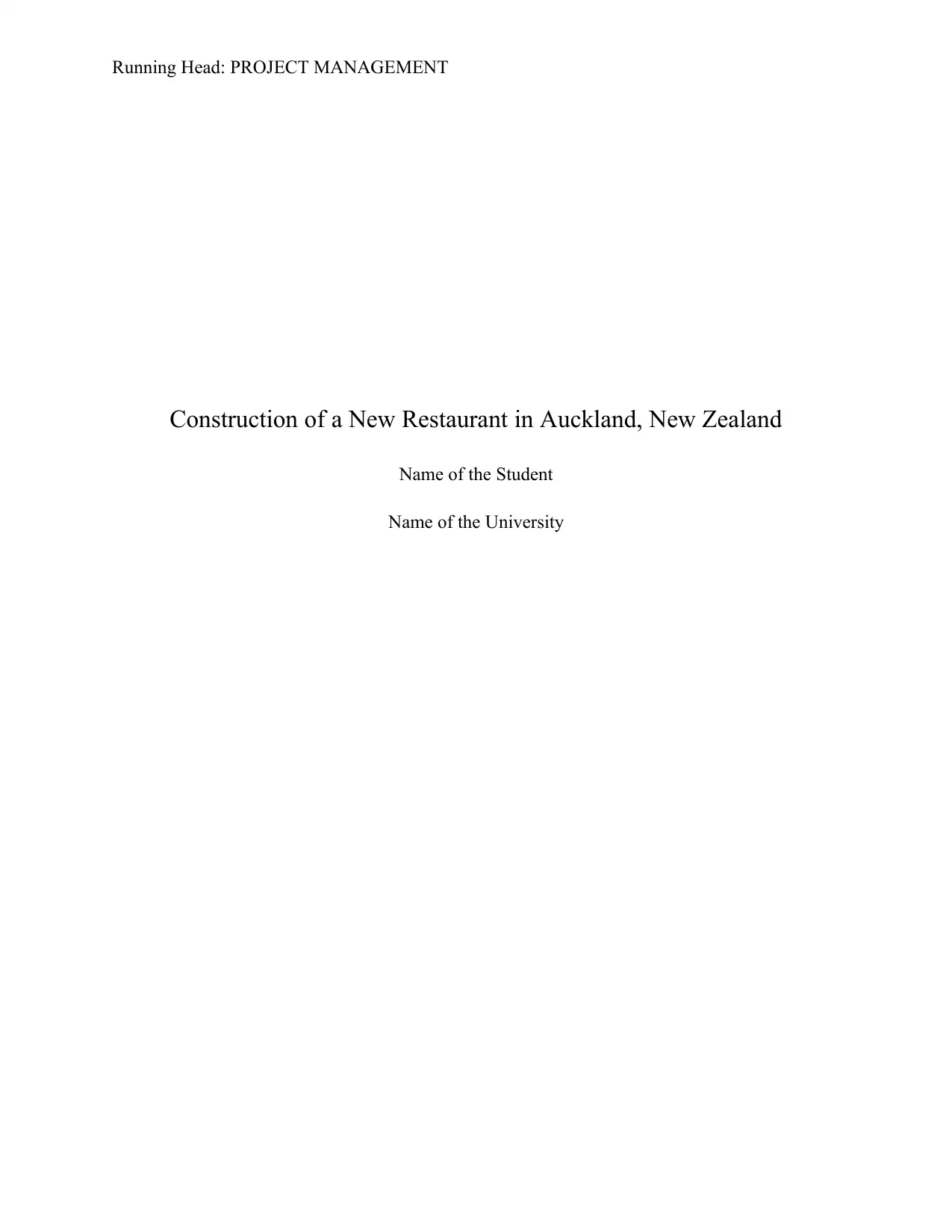
Running Head: PROJECT MANAGEMENT
Construction of a New Restaurant in Auckland, New Zealand
Name of the Student
Name of the University
Construction of a New Restaurant in Auckland, New Zealand
Name of the Student
Name of the University
Secure Best Marks with AI Grader
Need help grading? Try our AI Grader for instant feedback on your assignments.
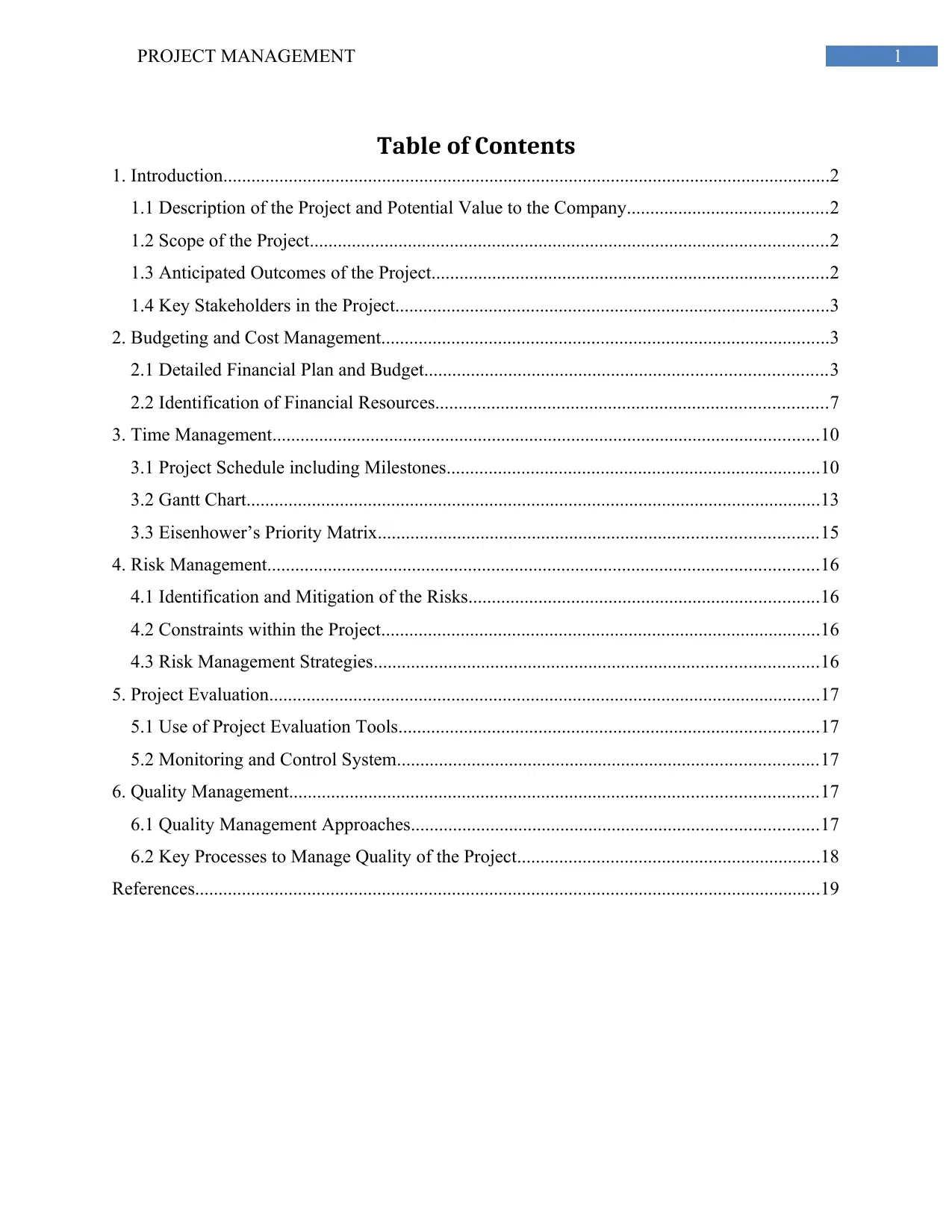
1PROJECT MANAGEMENT
Table of Contents
1. Introduction..................................................................................................................................2
1.1 Description of the Project and Potential Value to the Company...........................................2
1.2 Scope of the Project...............................................................................................................2
1.3 Anticipated Outcomes of the Project.....................................................................................2
1.4 Key Stakeholders in the Project.............................................................................................3
2. Budgeting and Cost Management................................................................................................3
2.1 Detailed Financial Plan and Budget......................................................................................3
2.2 Identification of Financial Resources....................................................................................7
3. Time Management.....................................................................................................................10
3.1 Project Schedule including Milestones................................................................................10
3.2 Gantt Chart...........................................................................................................................13
3.3 Eisenhower’s Priority Matrix..............................................................................................15
4. Risk Management......................................................................................................................16
4.1 Identification and Mitigation of the Risks...........................................................................16
4.2 Constraints within the Project..............................................................................................16
4.3 Risk Management Strategies...............................................................................................16
5. Project Evaluation......................................................................................................................17
5.1 Use of Project Evaluation Tools..........................................................................................17
5.2 Monitoring and Control System..........................................................................................17
6. Quality Management.................................................................................................................17
6.1 Quality Management Approaches.......................................................................................17
6.2 Key Processes to Manage Quality of the Project.................................................................18
References......................................................................................................................................19
Table of Contents
1. Introduction..................................................................................................................................2
1.1 Description of the Project and Potential Value to the Company...........................................2
1.2 Scope of the Project...............................................................................................................2
1.3 Anticipated Outcomes of the Project.....................................................................................2
1.4 Key Stakeholders in the Project.............................................................................................3
2. Budgeting and Cost Management................................................................................................3
2.1 Detailed Financial Plan and Budget......................................................................................3
2.2 Identification of Financial Resources....................................................................................7
3. Time Management.....................................................................................................................10
3.1 Project Schedule including Milestones................................................................................10
3.2 Gantt Chart...........................................................................................................................13
3.3 Eisenhower’s Priority Matrix..............................................................................................15
4. Risk Management......................................................................................................................16
4.1 Identification and Mitigation of the Risks...........................................................................16
4.2 Constraints within the Project..............................................................................................16
4.3 Risk Management Strategies...............................................................................................16
5. Project Evaluation......................................................................................................................17
5.1 Use of Project Evaluation Tools..........................................................................................17
5.2 Monitoring and Control System..........................................................................................17
6. Quality Management.................................................................................................................17
6.1 Quality Management Approaches.......................................................................................17
6.2 Key Processes to Manage Quality of the Project.................................................................18
References......................................................................................................................................19
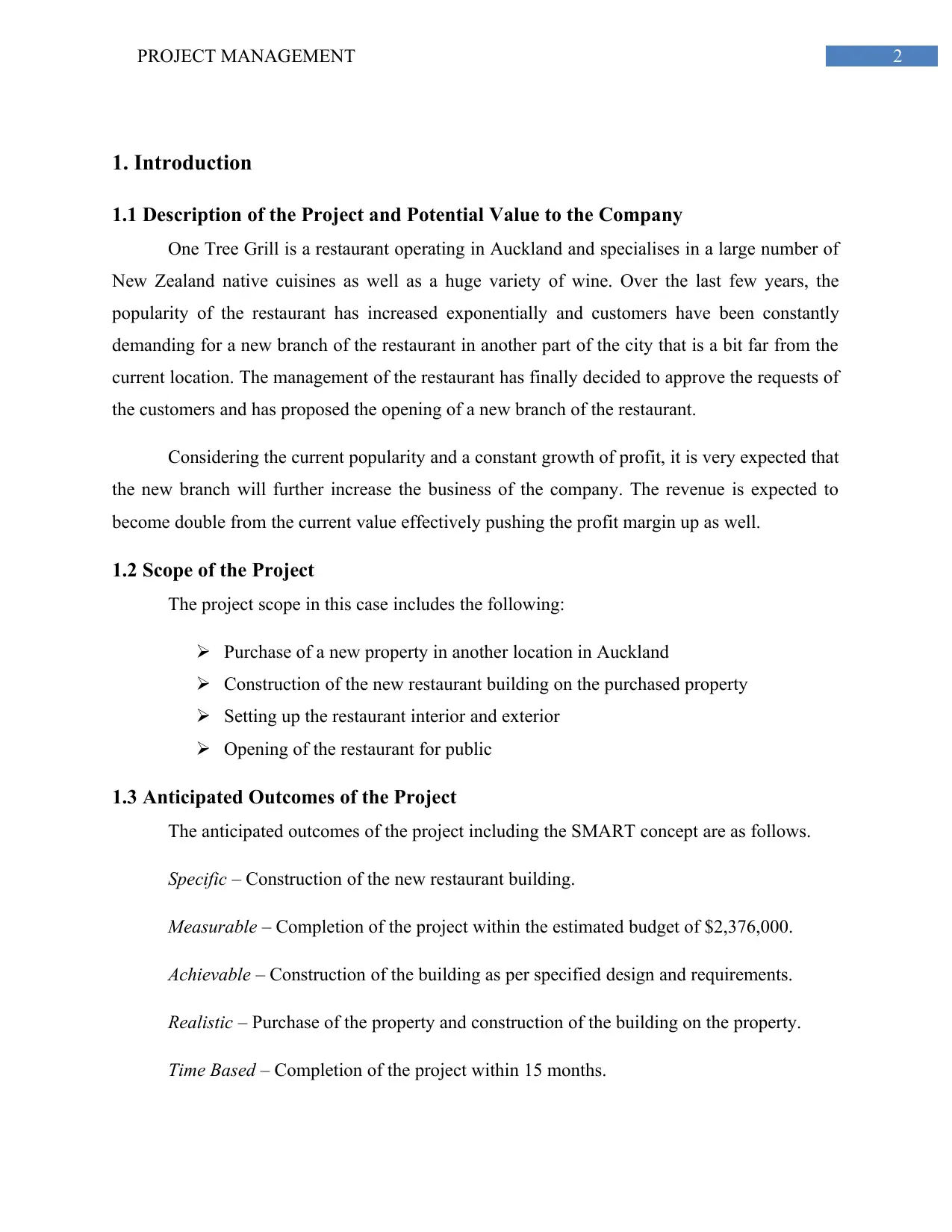
2PROJECT MANAGEMENT
1. Introduction
1.1 Description of the Project and Potential Value to the Company
One Tree Grill is a restaurant operating in Auckland and specialises in a large number of
New Zealand native cuisines as well as a huge variety of wine. Over the last few years, the
popularity of the restaurant has increased exponentially and customers have been constantly
demanding for a new branch of the restaurant in another part of the city that is a bit far from the
current location. The management of the restaurant has finally decided to approve the requests of
the customers and has proposed the opening of a new branch of the restaurant.
Considering the current popularity and a constant growth of profit, it is very expected that
the new branch will further increase the business of the company. The revenue is expected to
become double from the current value effectively pushing the profit margin up as well.
1.2 Scope of the Project
The project scope in this case includes the following:
Purchase of a new property in another location in Auckland
Construction of the new restaurant building on the purchased property
Setting up the restaurant interior and exterior
Opening of the restaurant for public
1.3 Anticipated Outcomes of the Project
The anticipated outcomes of the project including the SMART concept are as follows.
Specific – Construction of the new restaurant building.
Measurable – Completion of the project within the estimated budget of $2,376,000.
Achievable – Construction of the building as per specified design and requirements.
Realistic – Purchase of the property and construction of the building on the property.
Time Based – Completion of the project within 15 months.
1. Introduction
1.1 Description of the Project and Potential Value to the Company
One Tree Grill is a restaurant operating in Auckland and specialises in a large number of
New Zealand native cuisines as well as a huge variety of wine. Over the last few years, the
popularity of the restaurant has increased exponentially and customers have been constantly
demanding for a new branch of the restaurant in another part of the city that is a bit far from the
current location. The management of the restaurant has finally decided to approve the requests of
the customers and has proposed the opening of a new branch of the restaurant.
Considering the current popularity and a constant growth of profit, it is very expected that
the new branch will further increase the business of the company. The revenue is expected to
become double from the current value effectively pushing the profit margin up as well.
1.2 Scope of the Project
The project scope in this case includes the following:
Purchase of a new property in another location in Auckland
Construction of the new restaurant building on the purchased property
Setting up the restaurant interior and exterior
Opening of the restaurant for public
1.3 Anticipated Outcomes of the Project
The anticipated outcomes of the project including the SMART concept are as follows.
Specific – Construction of the new restaurant building.
Measurable – Completion of the project within the estimated budget of $2,376,000.
Achievable – Construction of the building as per specified design and requirements.
Realistic – Purchase of the property and construction of the building on the property.
Time Based – Completion of the project within 15 months.
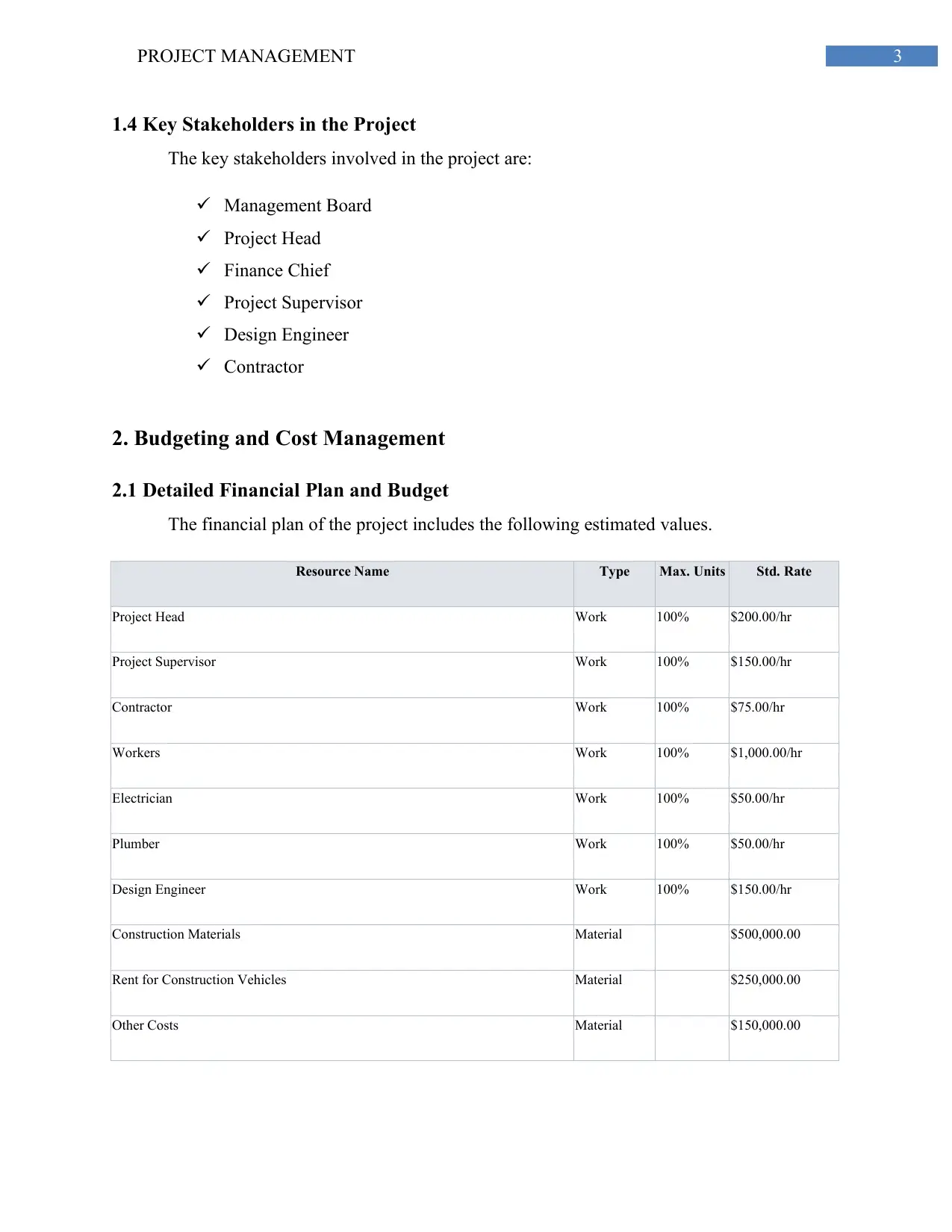
3PROJECT MANAGEMENT
1.4 Key Stakeholders in the Project
The key stakeholders involved in the project are:
Management Board
Project Head
Finance Chief
Project Supervisor
Design Engineer
Contractor
2. Budgeting and Cost Management
2.1 Detailed Financial Plan and Budget
The financial plan of the project includes the following estimated values.
Resource Name Type Max. Units Std. Rate
Project Head Work 100% $200.00/hr
Project Supervisor Work 100% $150.00/hr
Contractor Work 100% $75.00/hr
Workers Work 100% $1,000.00/hr
Electrician Work 100% $50.00/hr
Plumber Work 100% $50.00/hr
Design Engineer Work 100% $150.00/hr
Construction Materials Material $500,000.00
Rent for Construction Vehicles Material $250,000.00
Other Costs Material $150,000.00
1.4 Key Stakeholders in the Project
The key stakeholders involved in the project are:
Management Board
Project Head
Finance Chief
Project Supervisor
Design Engineer
Contractor
2. Budgeting and Cost Management
2.1 Detailed Financial Plan and Budget
The financial plan of the project includes the following estimated values.
Resource Name Type Max. Units Std. Rate
Project Head Work 100% $200.00/hr
Project Supervisor Work 100% $150.00/hr
Contractor Work 100% $75.00/hr
Workers Work 100% $1,000.00/hr
Electrician Work 100% $50.00/hr
Plumber Work 100% $50.00/hr
Design Engineer Work 100% $150.00/hr
Construction Materials Material $500,000.00
Rent for Construction Vehicles Material $250,000.00
Other Costs Material $150,000.00
Secure Best Marks with AI Grader
Need help grading? Try our AI Grader for instant feedback on your assignments.
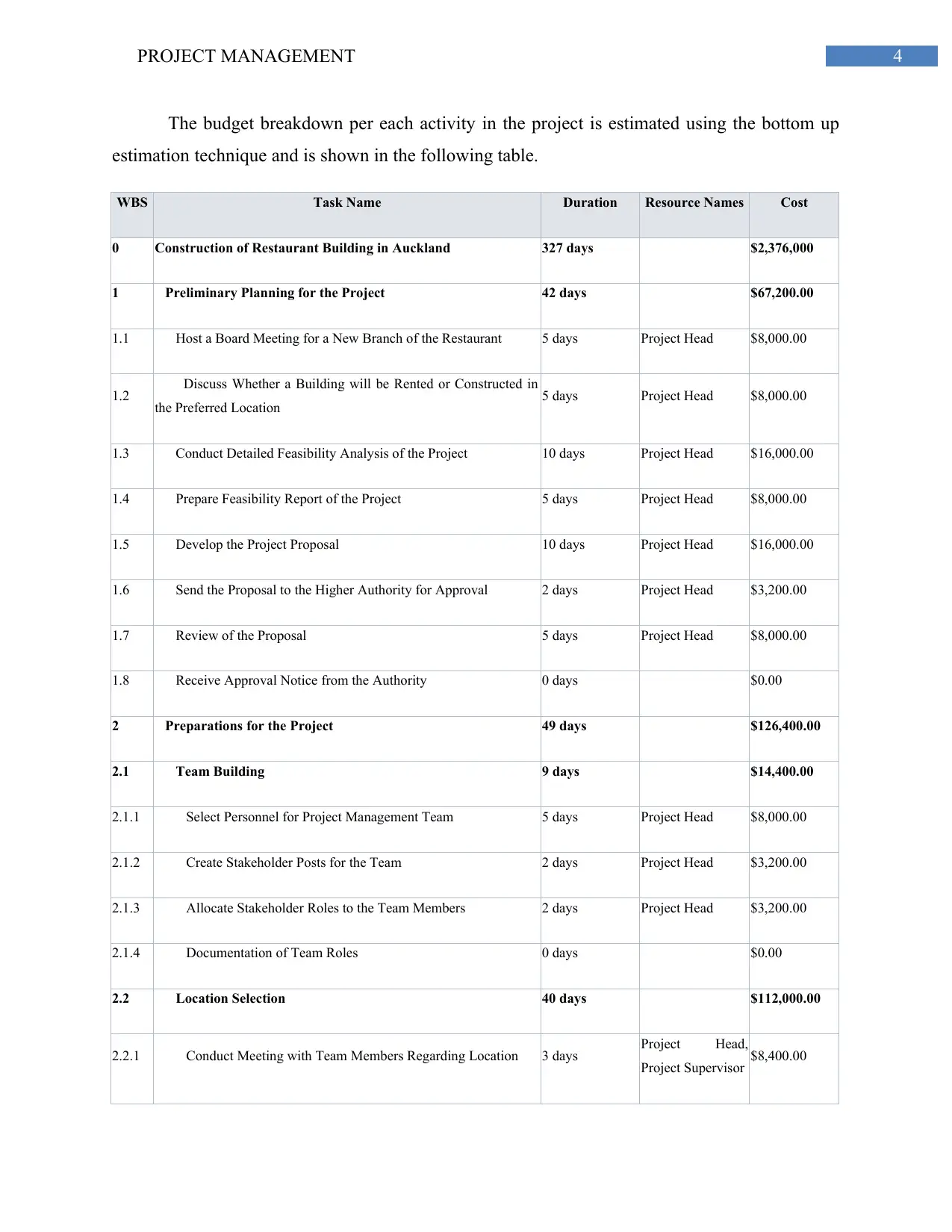
4PROJECT MANAGEMENT
The budget breakdown per each activity in the project is estimated using the bottom up
estimation technique and is shown in the following table.
WBS Task Name Duration Resource Names Cost
0 Construction of Restaurant Building in Auckland 327 days $2,376,000
1 Preliminary Planning for the Project 42 days $67,200.00
1.1 Host a Board Meeting for a New Branch of the Restaurant 5 days Project Head $8,000.00
1.2 Discuss Whether a Building will be Rented or Constructed in
the Preferred Location 5 days Project Head $8,000.00
1.3 Conduct Detailed Feasibility Analysis of the Project 10 days Project Head $16,000.00
1.4 Prepare Feasibility Report of the Project 5 days Project Head $8,000.00
1.5 Develop the Project Proposal 10 days Project Head $16,000.00
1.6 Send the Proposal to the Higher Authority for Approval 2 days Project Head $3,200.00
1.7 Review of the Proposal 5 days Project Head $8,000.00
1.8 Receive Approval Notice from the Authority 0 days $0.00
2 Preparations for the Project 49 days $126,400.00
2.1 Team Building 9 days $14,400.00
2.1.1 Select Personnel for Project Management Team 5 days Project Head $8,000.00
2.1.2 Create Stakeholder Posts for the Team 2 days Project Head $3,200.00
2.1.3 Allocate Stakeholder Roles to the Team Members 2 days Project Head $3,200.00
2.1.4 Documentation of Team Roles 0 days $0.00
2.2 Location Selection 40 days $112,000.00
2.2.1 Conduct Meeting with Team Members Regarding Location 3 days Project Head,
Project Supervisor $8,400.00
The budget breakdown per each activity in the project is estimated using the bottom up
estimation technique and is shown in the following table.
WBS Task Name Duration Resource Names Cost
0 Construction of Restaurant Building in Auckland 327 days $2,376,000
1 Preliminary Planning for the Project 42 days $67,200.00
1.1 Host a Board Meeting for a New Branch of the Restaurant 5 days Project Head $8,000.00
1.2 Discuss Whether a Building will be Rented or Constructed in
the Preferred Location 5 days Project Head $8,000.00
1.3 Conduct Detailed Feasibility Analysis of the Project 10 days Project Head $16,000.00
1.4 Prepare Feasibility Report of the Project 5 days Project Head $8,000.00
1.5 Develop the Project Proposal 10 days Project Head $16,000.00
1.6 Send the Proposal to the Higher Authority for Approval 2 days Project Head $3,200.00
1.7 Review of the Proposal 5 days Project Head $8,000.00
1.8 Receive Approval Notice from the Authority 0 days $0.00
2 Preparations for the Project 49 days $126,400.00
2.1 Team Building 9 days $14,400.00
2.1.1 Select Personnel for Project Management Team 5 days Project Head $8,000.00
2.1.2 Create Stakeholder Posts for the Team 2 days Project Head $3,200.00
2.1.3 Allocate Stakeholder Roles to the Team Members 2 days Project Head $3,200.00
2.1.4 Documentation of Team Roles 0 days $0.00
2.2 Location Selection 40 days $112,000.00
2.2.1 Conduct Meeting with Team Members Regarding Location 3 days Project Head,
Project Supervisor $8,400.00
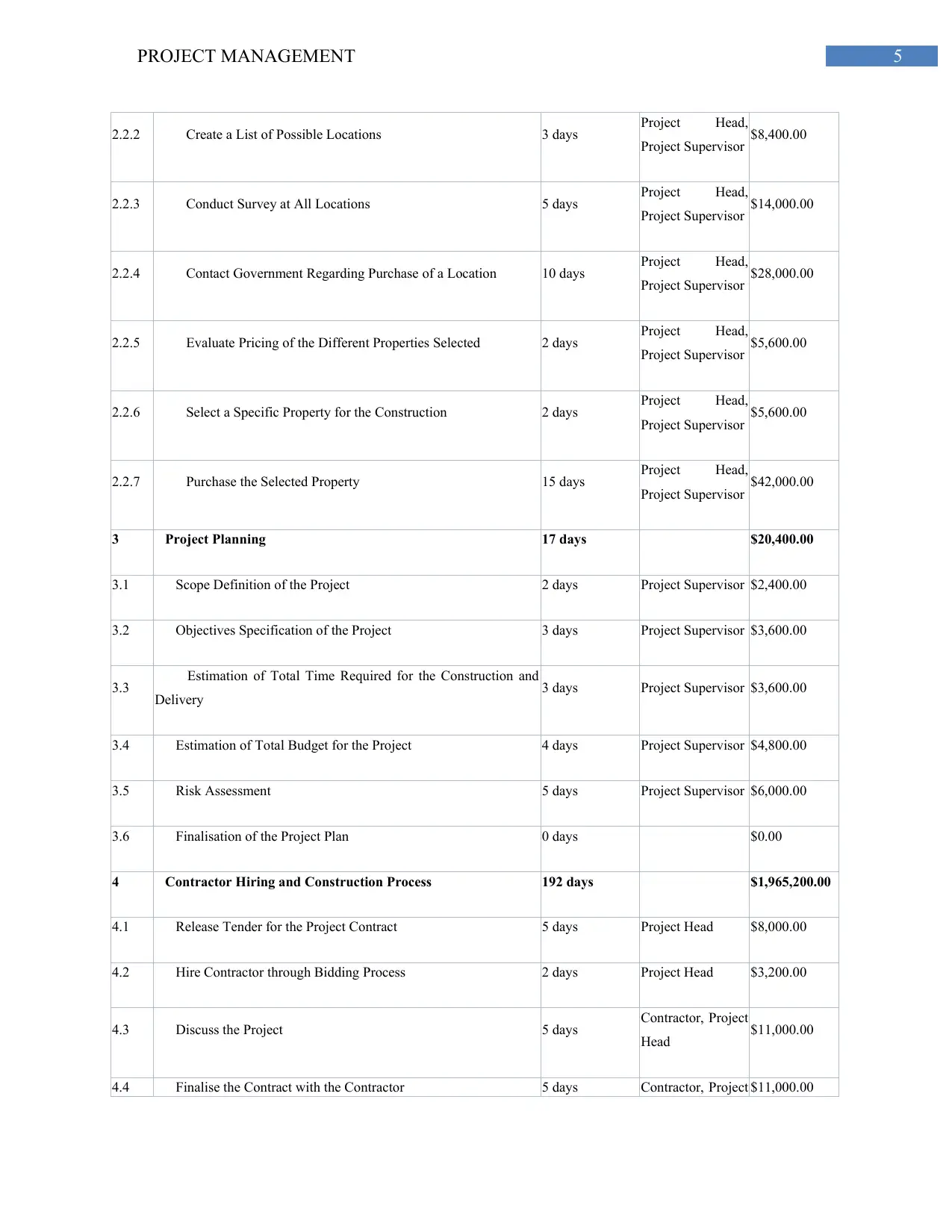
5PROJECT MANAGEMENT
2.2.2 Create a List of Possible Locations 3 days Project Head,
Project Supervisor $8,400.00
2.2.3 Conduct Survey at All Locations 5 days Project Head,
Project Supervisor $14,000.00
2.2.4 Contact Government Regarding Purchase of a Location 10 days Project Head,
Project Supervisor $28,000.00
2.2.5 Evaluate Pricing of the Different Properties Selected 2 days Project Head,
Project Supervisor $5,600.00
2.2.6 Select a Specific Property for the Construction 2 days Project Head,
Project Supervisor $5,600.00
2.2.7 Purchase the Selected Property 15 days Project Head,
Project Supervisor $42,000.00
3 Project Planning 17 days $20,400.00
3.1 Scope Definition of the Project 2 days Project Supervisor $2,400.00
3.2 Objectives Specification of the Project 3 days Project Supervisor $3,600.00
3.3 Estimation of Total Time Required for the Construction and
Delivery 3 days Project Supervisor $3,600.00
3.4 Estimation of Total Budget for the Project 4 days Project Supervisor $4,800.00
3.5 Risk Assessment 5 days Project Supervisor $6,000.00
3.6 Finalisation of the Project Plan 0 days $0.00
4 Contractor Hiring and Construction Process 192 days $1,965,200.00
4.1 Release Tender for the Project Contract 5 days Project Head $8,000.00
4.2 Hire Contractor through Bidding Process 2 days Project Head $3,200.00
4.3 Discuss the Project 5 days Contractor, Project
Head $11,000.00
4.4 Finalise the Contract with the Contractor 5 days Contractor, Project $11,000.00
2.2.2 Create a List of Possible Locations 3 days Project Head,
Project Supervisor $8,400.00
2.2.3 Conduct Survey at All Locations 5 days Project Head,
Project Supervisor $14,000.00
2.2.4 Contact Government Regarding Purchase of a Location 10 days Project Head,
Project Supervisor $28,000.00
2.2.5 Evaluate Pricing of the Different Properties Selected 2 days Project Head,
Project Supervisor $5,600.00
2.2.6 Select a Specific Property for the Construction 2 days Project Head,
Project Supervisor $5,600.00
2.2.7 Purchase the Selected Property 15 days Project Head,
Project Supervisor $42,000.00
3 Project Planning 17 days $20,400.00
3.1 Scope Definition of the Project 2 days Project Supervisor $2,400.00
3.2 Objectives Specification of the Project 3 days Project Supervisor $3,600.00
3.3 Estimation of Total Time Required for the Construction and
Delivery 3 days Project Supervisor $3,600.00
3.4 Estimation of Total Budget for the Project 4 days Project Supervisor $4,800.00
3.5 Risk Assessment 5 days Project Supervisor $6,000.00
3.6 Finalisation of the Project Plan 0 days $0.00
4 Contractor Hiring and Construction Process 192 days $1,965,200.00
4.1 Release Tender for the Project Contract 5 days Project Head $8,000.00
4.2 Hire Contractor through Bidding Process 2 days Project Head $3,200.00
4.3 Discuss the Project 5 days Contractor, Project
Head $11,000.00
4.4 Finalise the Contract with the Contractor 5 days Contractor, Project $11,000.00
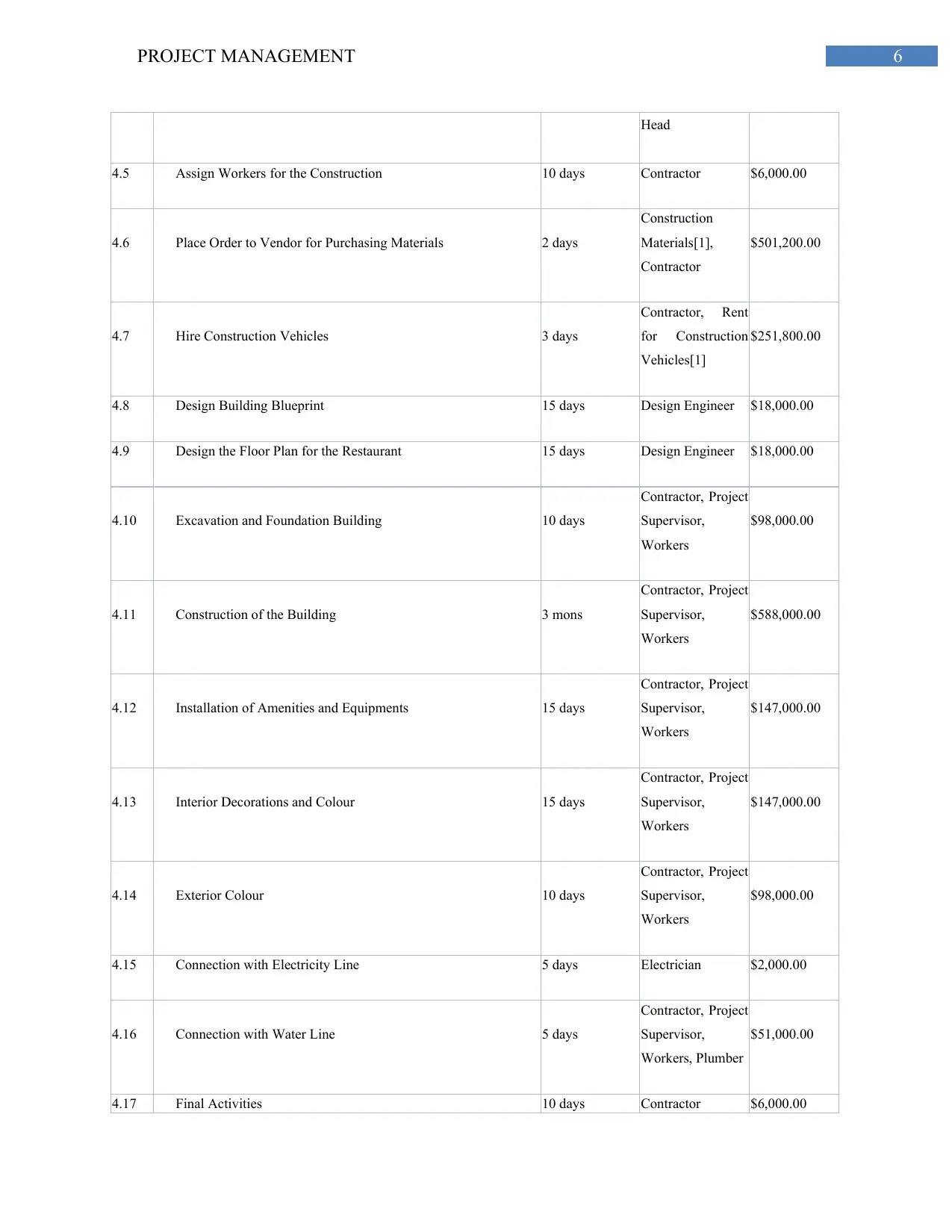
6PROJECT MANAGEMENT
Head
4.5 Assign Workers for the Construction 10 days Contractor $6,000.00
4.6 Place Order to Vendor for Purchasing Materials 2 days
Construction
Materials[1],
Contractor
$501,200.00
4.7 Hire Construction Vehicles 3 days
Contractor, Rent
for Construction
Vehicles[1]
$251,800.00
4.8 Design Building Blueprint 15 days Design Engineer $18,000.00
4.9 Design the Floor Plan for the Restaurant 15 days Design Engineer $18,000.00
4.10 Excavation and Foundation Building 10 days
Contractor, Project
Supervisor,
Workers
$98,000.00
4.11 Construction of the Building 3 mons
Contractor, Project
Supervisor,
Workers
$588,000.00
4.12 Installation of Amenities and Equipments 15 days
Contractor, Project
Supervisor,
Workers
$147,000.00
4.13 Interior Decorations and Colour 15 days
Contractor, Project
Supervisor,
Workers
$147,000.00
4.14 Exterior Colour 10 days
Contractor, Project
Supervisor,
Workers
$98,000.00
4.15 Connection with Electricity Line 5 days Electrician $2,000.00
4.16 Connection with Water Line 5 days
Contractor, Project
Supervisor,
Workers, Plumber
$51,000.00
4.17 Final Activities 10 days Contractor $6,000.00
Head
4.5 Assign Workers for the Construction 10 days Contractor $6,000.00
4.6 Place Order to Vendor for Purchasing Materials 2 days
Construction
Materials[1],
Contractor
$501,200.00
4.7 Hire Construction Vehicles 3 days
Contractor, Rent
for Construction
Vehicles[1]
$251,800.00
4.8 Design Building Blueprint 15 days Design Engineer $18,000.00
4.9 Design the Floor Plan for the Restaurant 15 days Design Engineer $18,000.00
4.10 Excavation and Foundation Building 10 days
Contractor, Project
Supervisor,
Workers
$98,000.00
4.11 Construction of the Building 3 mons
Contractor, Project
Supervisor,
Workers
$588,000.00
4.12 Installation of Amenities and Equipments 15 days
Contractor, Project
Supervisor,
Workers
$147,000.00
4.13 Interior Decorations and Colour 15 days
Contractor, Project
Supervisor,
Workers
$147,000.00
4.14 Exterior Colour 10 days
Contractor, Project
Supervisor,
Workers
$98,000.00
4.15 Connection with Electricity Line 5 days Electrician $2,000.00
4.16 Connection with Water Line 5 days
Contractor, Project
Supervisor,
Workers, Plumber
$51,000.00
4.17 Final Activities 10 days Contractor $6,000.00
Paraphrase This Document
Need a fresh take? Get an instant paraphrase of this document with our AI Paraphraser
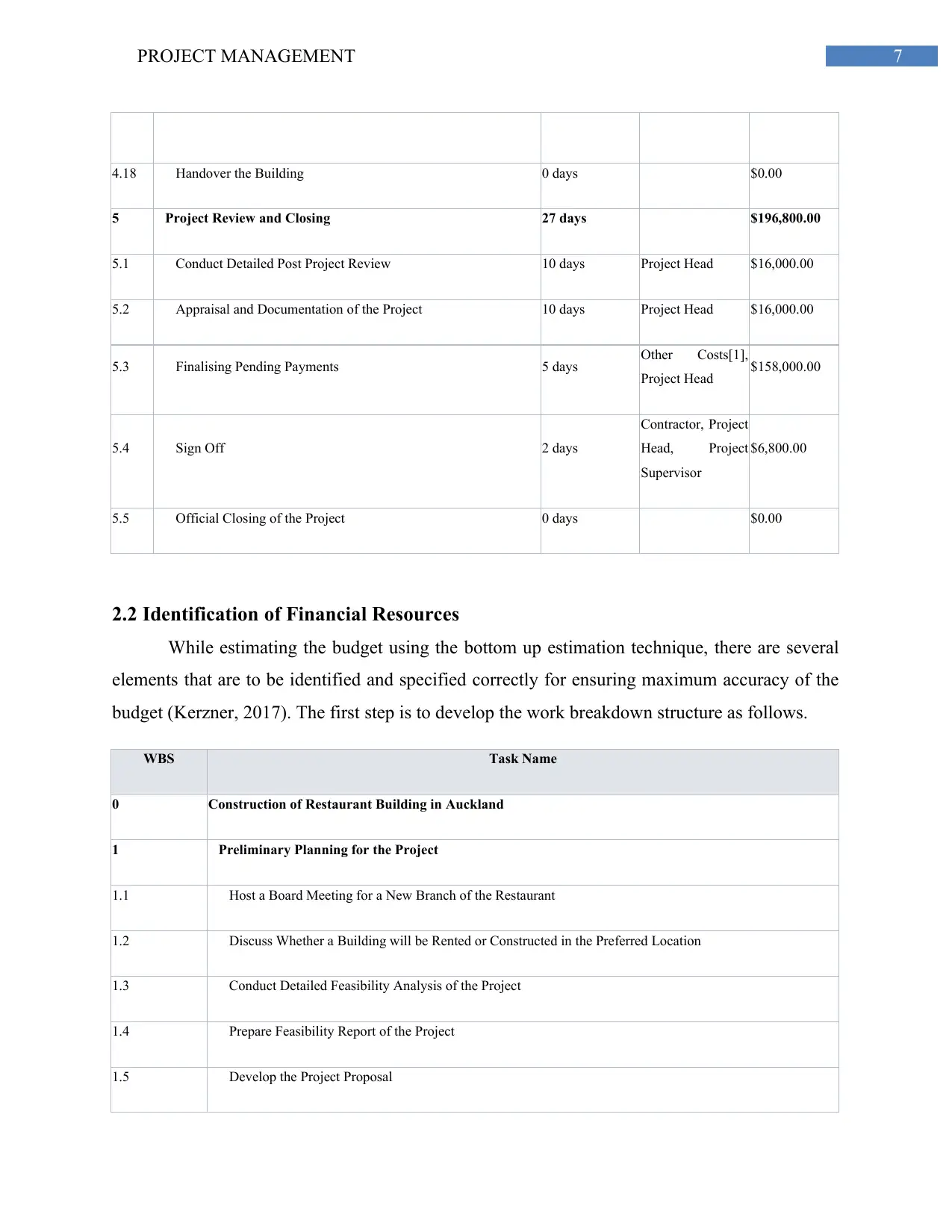
7PROJECT MANAGEMENT
4.18 Handover the Building 0 days $0.00
5 Project Review and Closing 27 days $196,800.00
5.1 Conduct Detailed Post Project Review 10 days Project Head $16,000.00
5.2 Appraisal and Documentation of the Project 10 days Project Head $16,000.00
5.3 Finalising Pending Payments 5 days Other Costs[1],
Project Head $158,000.00
5.4 Sign Off 2 days
Contractor, Project
Head, Project
Supervisor
$6,800.00
5.5 Official Closing of the Project 0 days $0.00
2.2 Identification of Financial Resources
While estimating the budget using the bottom up estimation technique, there are several
elements that are to be identified and specified correctly for ensuring maximum accuracy of the
budget (Kerzner, 2017). The first step is to develop the work breakdown structure as follows.
WBS Task Name
0 Construction of Restaurant Building in Auckland
1 Preliminary Planning for the Project
1.1 Host a Board Meeting for a New Branch of the Restaurant
1.2 Discuss Whether a Building will be Rented or Constructed in the Preferred Location
1.3 Conduct Detailed Feasibility Analysis of the Project
1.4 Prepare Feasibility Report of the Project
1.5 Develop the Project Proposal
4.18 Handover the Building 0 days $0.00
5 Project Review and Closing 27 days $196,800.00
5.1 Conduct Detailed Post Project Review 10 days Project Head $16,000.00
5.2 Appraisal and Documentation of the Project 10 days Project Head $16,000.00
5.3 Finalising Pending Payments 5 days Other Costs[1],
Project Head $158,000.00
5.4 Sign Off 2 days
Contractor, Project
Head, Project
Supervisor
$6,800.00
5.5 Official Closing of the Project 0 days $0.00
2.2 Identification of Financial Resources
While estimating the budget using the bottom up estimation technique, there are several
elements that are to be identified and specified correctly for ensuring maximum accuracy of the
budget (Kerzner, 2017). The first step is to develop the work breakdown structure as follows.
WBS Task Name
0 Construction of Restaurant Building in Auckland
1 Preliminary Planning for the Project
1.1 Host a Board Meeting for a New Branch of the Restaurant
1.2 Discuss Whether a Building will be Rented or Constructed in the Preferred Location
1.3 Conduct Detailed Feasibility Analysis of the Project
1.4 Prepare Feasibility Report of the Project
1.5 Develop the Project Proposal
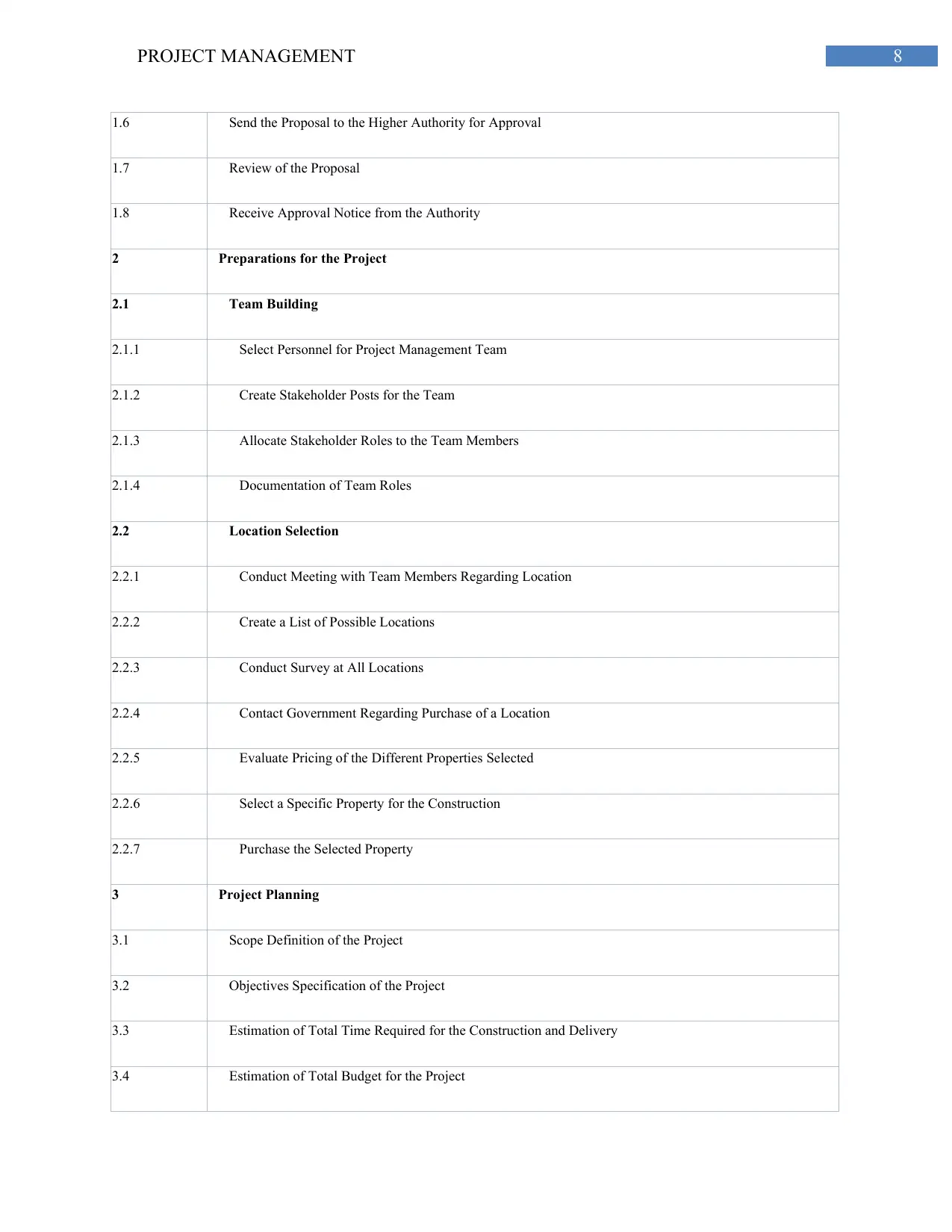
8PROJECT MANAGEMENT
1.6 Send the Proposal to the Higher Authority for Approval
1.7 Review of the Proposal
1.8 Receive Approval Notice from the Authority
2 Preparations for the Project
2.1 Team Building
2.1.1 Select Personnel for Project Management Team
2.1.2 Create Stakeholder Posts for the Team
2.1.3 Allocate Stakeholder Roles to the Team Members
2.1.4 Documentation of Team Roles
2.2 Location Selection
2.2.1 Conduct Meeting with Team Members Regarding Location
2.2.2 Create a List of Possible Locations
2.2.3 Conduct Survey at All Locations
2.2.4 Contact Government Regarding Purchase of a Location
2.2.5 Evaluate Pricing of the Different Properties Selected
2.2.6 Select a Specific Property for the Construction
2.2.7 Purchase the Selected Property
3 Project Planning
3.1 Scope Definition of the Project
3.2 Objectives Specification of the Project
3.3 Estimation of Total Time Required for the Construction and Delivery
3.4 Estimation of Total Budget for the Project
1.6 Send the Proposal to the Higher Authority for Approval
1.7 Review of the Proposal
1.8 Receive Approval Notice from the Authority
2 Preparations for the Project
2.1 Team Building
2.1.1 Select Personnel for Project Management Team
2.1.2 Create Stakeholder Posts for the Team
2.1.3 Allocate Stakeholder Roles to the Team Members
2.1.4 Documentation of Team Roles
2.2 Location Selection
2.2.1 Conduct Meeting with Team Members Regarding Location
2.2.2 Create a List of Possible Locations
2.2.3 Conduct Survey at All Locations
2.2.4 Contact Government Regarding Purchase of a Location
2.2.5 Evaluate Pricing of the Different Properties Selected
2.2.6 Select a Specific Property for the Construction
2.2.7 Purchase the Selected Property
3 Project Planning
3.1 Scope Definition of the Project
3.2 Objectives Specification of the Project
3.3 Estimation of Total Time Required for the Construction and Delivery
3.4 Estimation of Total Budget for the Project
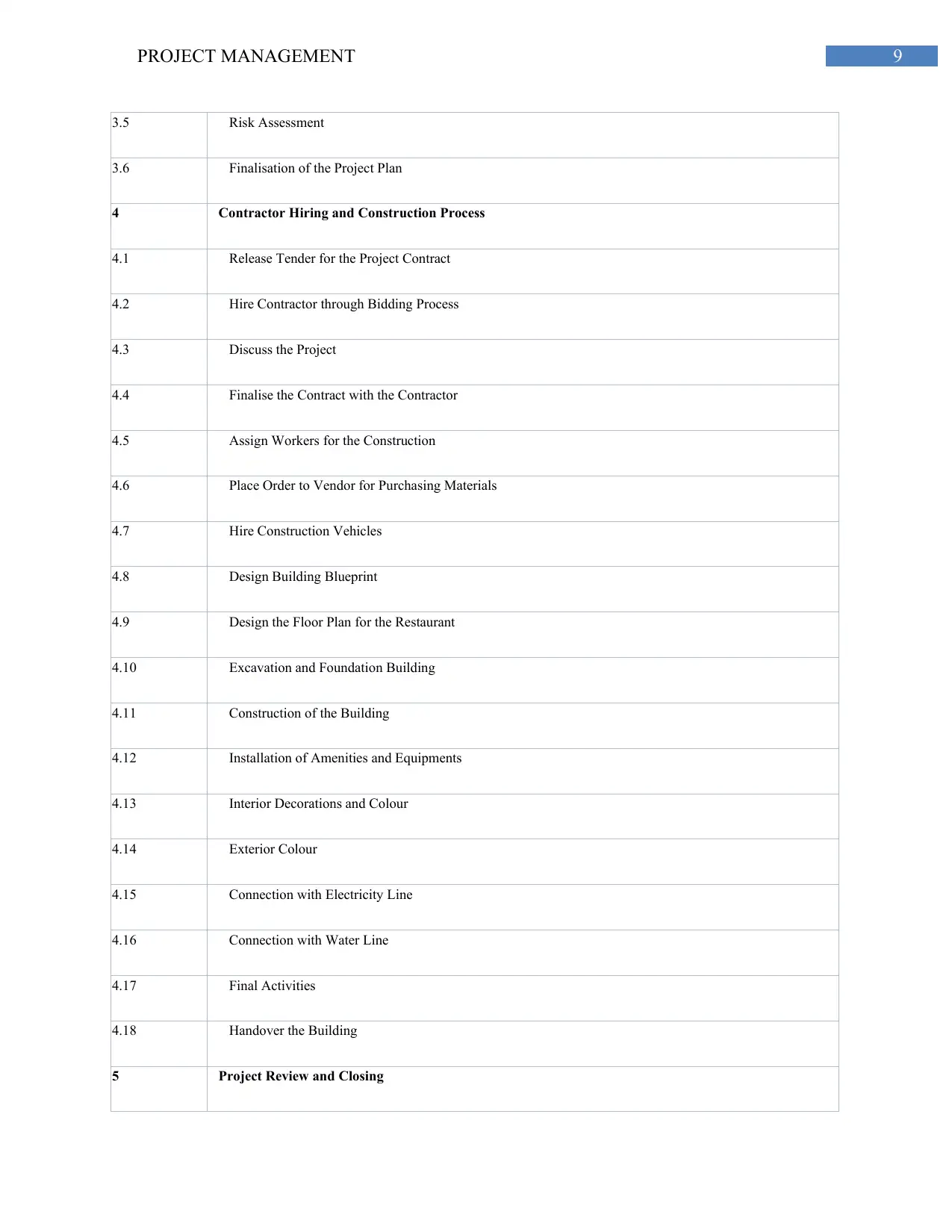
9PROJECT MANAGEMENT
3.5 Risk Assessment
3.6 Finalisation of the Project Plan
4 Contractor Hiring and Construction Process
4.1 Release Tender for the Project Contract
4.2 Hire Contractor through Bidding Process
4.3 Discuss the Project
4.4 Finalise the Contract with the Contractor
4.5 Assign Workers for the Construction
4.6 Place Order to Vendor for Purchasing Materials
4.7 Hire Construction Vehicles
4.8 Design Building Blueprint
4.9 Design the Floor Plan for the Restaurant
4.10 Excavation and Foundation Building
4.11 Construction of the Building
4.12 Installation of Amenities and Equipments
4.13 Interior Decorations and Colour
4.14 Exterior Colour
4.15 Connection with Electricity Line
4.16 Connection with Water Line
4.17 Final Activities
4.18 Handover the Building
5 Project Review and Closing
3.5 Risk Assessment
3.6 Finalisation of the Project Plan
4 Contractor Hiring and Construction Process
4.1 Release Tender for the Project Contract
4.2 Hire Contractor through Bidding Process
4.3 Discuss the Project
4.4 Finalise the Contract with the Contractor
4.5 Assign Workers for the Construction
4.6 Place Order to Vendor for Purchasing Materials
4.7 Hire Construction Vehicles
4.8 Design Building Blueprint
4.9 Design the Floor Plan for the Restaurant
4.10 Excavation and Foundation Building
4.11 Construction of the Building
4.12 Installation of Amenities and Equipments
4.13 Interior Decorations and Colour
4.14 Exterior Colour
4.15 Connection with Electricity Line
4.16 Connection with Water Line
4.17 Final Activities
4.18 Handover the Building
5 Project Review and Closing
Secure Best Marks with AI Grader
Need help grading? Try our AI Grader for instant feedback on your assignments.
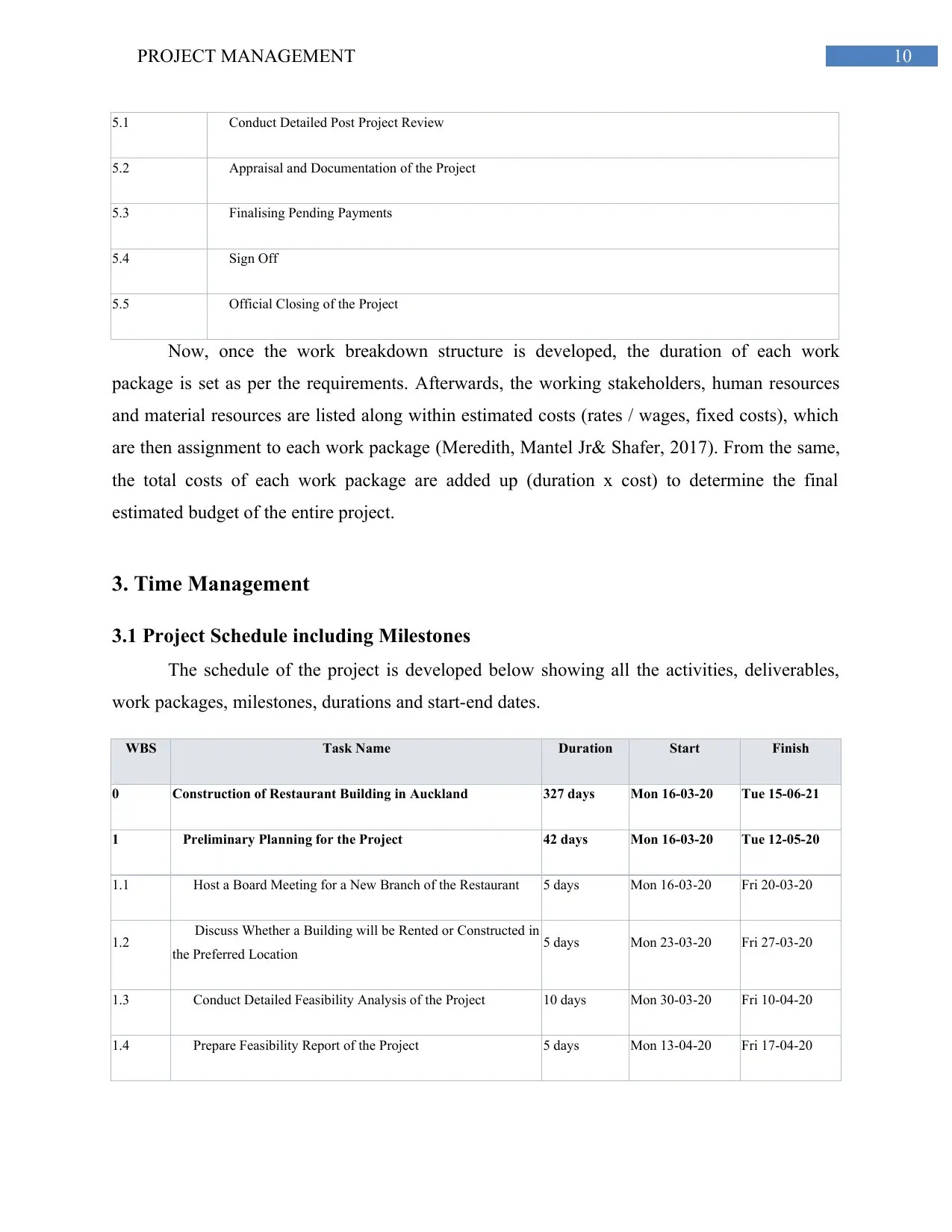
10PROJECT MANAGEMENT
5.1 Conduct Detailed Post Project Review
5.2 Appraisal and Documentation of the Project
5.3 Finalising Pending Payments
5.4 Sign Off
5.5 Official Closing of the Project
Now, once the work breakdown structure is developed, the duration of each work
package is set as per the requirements. Afterwards, the working stakeholders, human resources
and material resources are listed along within estimated costs (rates / wages, fixed costs), which
are then assignment to each work package (Meredith, Mantel Jr& Shafer, 2017). From the same,
the total costs of each work package are added up (duration x cost) to determine the final
estimated budget of the entire project.
3. Time Management
3.1 Project Schedule including Milestones
The schedule of the project is developed below showing all the activities, deliverables,
work packages, milestones, durations and start-end dates.
WBS Task Name Duration Start Finish
0 Construction of Restaurant Building in Auckland 327 days Mon 16-03-20 Tue 15-06-21
1 Preliminary Planning for the Project 42 days Mon 16-03-20 Tue 12-05-20
1.1 Host a Board Meeting for a New Branch of the Restaurant 5 days Mon 16-03-20 Fri 20-03-20
1.2 Discuss Whether a Building will be Rented or Constructed in
the Preferred Location 5 days Mon 23-03-20 Fri 27-03-20
1.3 Conduct Detailed Feasibility Analysis of the Project 10 days Mon 30-03-20 Fri 10-04-20
1.4 Prepare Feasibility Report of the Project 5 days Mon 13-04-20 Fri 17-04-20
5.1 Conduct Detailed Post Project Review
5.2 Appraisal and Documentation of the Project
5.3 Finalising Pending Payments
5.4 Sign Off
5.5 Official Closing of the Project
Now, once the work breakdown structure is developed, the duration of each work
package is set as per the requirements. Afterwards, the working stakeholders, human resources
and material resources are listed along within estimated costs (rates / wages, fixed costs), which
are then assignment to each work package (Meredith, Mantel Jr& Shafer, 2017). From the same,
the total costs of each work package are added up (duration x cost) to determine the final
estimated budget of the entire project.
3. Time Management
3.1 Project Schedule including Milestones
The schedule of the project is developed below showing all the activities, deliverables,
work packages, milestones, durations and start-end dates.
WBS Task Name Duration Start Finish
0 Construction of Restaurant Building in Auckland 327 days Mon 16-03-20 Tue 15-06-21
1 Preliminary Planning for the Project 42 days Mon 16-03-20 Tue 12-05-20
1.1 Host a Board Meeting for a New Branch of the Restaurant 5 days Mon 16-03-20 Fri 20-03-20
1.2 Discuss Whether a Building will be Rented or Constructed in
the Preferred Location 5 days Mon 23-03-20 Fri 27-03-20
1.3 Conduct Detailed Feasibility Analysis of the Project 10 days Mon 30-03-20 Fri 10-04-20
1.4 Prepare Feasibility Report of the Project 5 days Mon 13-04-20 Fri 17-04-20
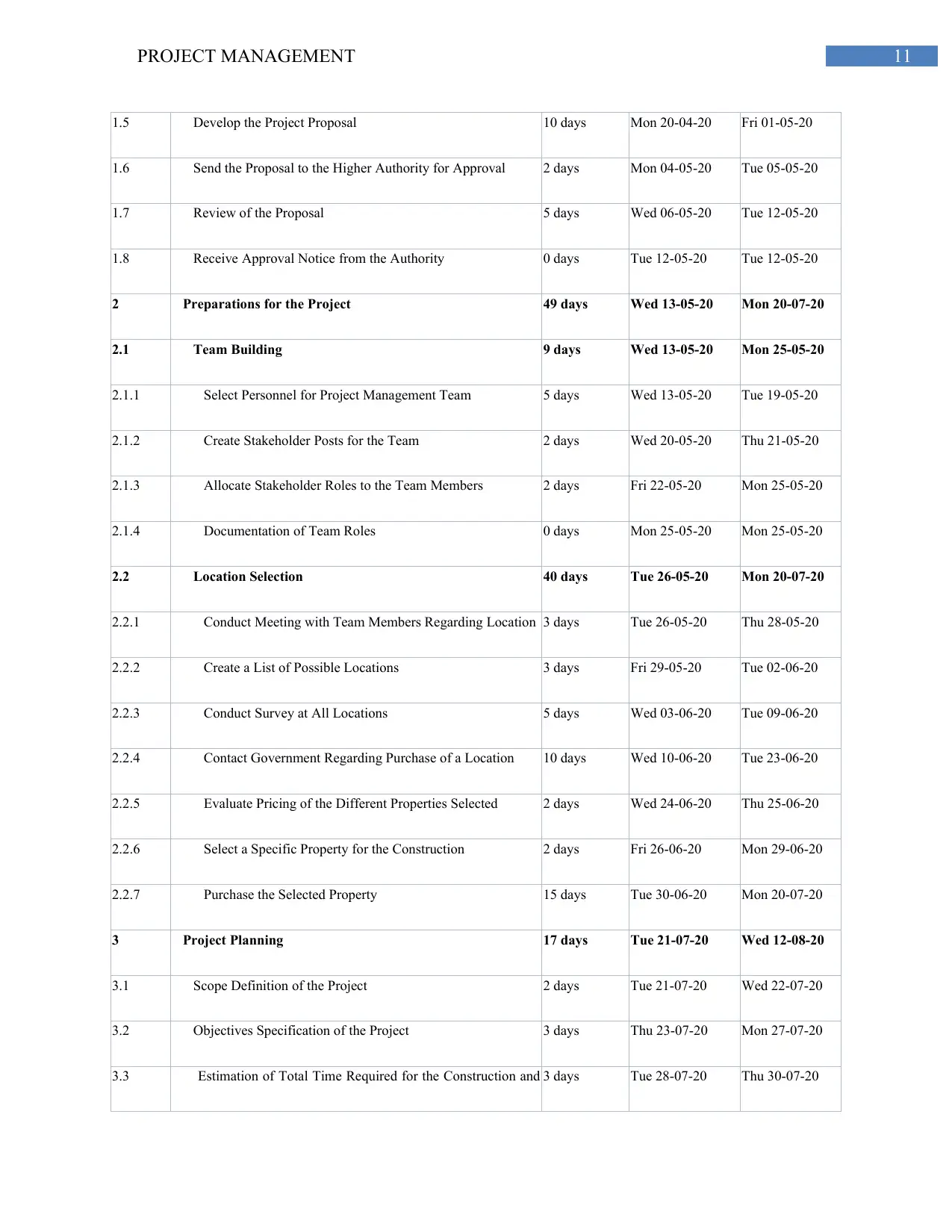
11PROJECT MANAGEMENT
1.5 Develop the Project Proposal 10 days Mon 20-04-20 Fri 01-05-20
1.6 Send the Proposal to the Higher Authority for Approval 2 days Mon 04-05-20 Tue 05-05-20
1.7 Review of the Proposal 5 days Wed 06-05-20 Tue 12-05-20
1.8 Receive Approval Notice from the Authority 0 days Tue 12-05-20 Tue 12-05-20
2 Preparations for the Project 49 days Wed 13-05-20 Mon 20-07-20
2.1 Team Building 9 days Wed 13-05-20 Mon 25-05-20
2.1.1 Select Personnel for Project Management Team 5 days Wed 13-05-20 Tue 19-05-20
2.1.2 Create Stakeholder Posts for the Team 2 days Wed 20-05-20 Thu 21-05-20
2.1.3 Allocate Stakeholder Roles to the Team Members 2 days Fri 22-05-20 Mon 25-05-20
2.1.4 Documentation of Team Roles 0 days Mon 25-05-20 Mon 25-05-20
2.2 Location Selection 40 days Tue 26-05-20 Mon 20-07-20
2.2.1 Conduct Meeting with Team Members Regarding Location 3 days Tue 26-05-20 Thu 28-05-20
2.2.2 Create a List of Possible Locations 3 days Fri 29-05-20 Tue 02-06-20
2.2.3 Conduct Survey at All Locations 5 days Wed 03-06-20 Tue 09-06-20
2.2.4 Contact Government Regarding Purchase of a Location 10 days Wed 10-06-20 Tue 23-06-20
2.2.5 Evaluate Pricing of the Different Properties Selected 2 days Wed 24-06-20 Thu 25-06-20
2.2.6 Select a Specific Property for the Construction 2 days Fri 26-06-20 Mon 29-06-20
2.2.7 Purchase the Selected Property 15 days Tue 30-06-20 Mon 20-07-20
3 Project Planning 17 days Tue 21-07-20 Wed 12-08-20
3.1 Scope Definition of the Project 2 days Tue 21-07-20 Wed 22-07-20
3.2 Objectives Specification of the Project 3 days Thu 23-07-20 Mon 27-07-20
3.3 Estimation of Total Time Required for the Construction and 3 days Tue 28-07-20 Thu 30-07-20
1.5 Develop the Project Proposal 10 days Mon 20-04-20 Fri 01-05-20
1.6 Send the Proposal to the Higher Authority for Approval 2 days Mon 04-05-20 Tue 05-05-20
1.7 Review of the Proposal 5 days Wed 06-05-20 Tue 12-05-20
1.8 Receive Approval Notice from the Authority 0 days Tue 12-05-20 Tue 12-05-20
2 Preparations for the Project 49 days Wed 13-05-20 Mon 20-07-20
2.1 Team Building 9 days Wed 13-05-20 Mon 25-05-20
2.1.1 Select Personnel for Project Management Team 5 days Wed 13-05-20 Tue 19-05-20
2.1.2 Create Stakeholder Posts for the Team 2 days Wed 20-05-20 Thu 21-05-20
2.1.3 Allocate Stakeholder Roles to the Team Members 2 days Fri 22-05-20 Mon 25-05-20
2.1.4 Documentation of Team Roles 0 days Mon 25-05-20 Mon 25-05-20
2.2 Location Selection 40 days Tue 26-05-20 Mon 20-07-20
2.2.1 Conduct Meeting with Team Members Regarding Location 3 days Tue 26-05-20 Thu 28-05-20
2.2.2 Create a List of Possible Locations 3 days Fri 29-05-20 Tue 02-06-20
2.2.3 Conduct Survey at All Locations 5 days Wed 03-06-20 Tue 09-06-20
2.2.4 Contact Government Regarding Purchase of a Location 10 days Wed 10-06-20 Tue 23-06-20
2.2.5 Evaluate Pricing of the Different Properties Selected 2 days Wed 24-06-20 Thu 25-06-20
2.2.6 Select a Specific Property for the Construction 2 days Fri 26-06-20 Mon 29-06-20
2.2.7 Purchase the Selected Property 15 days Tue 30-06-20 Mon 20-07-20
3 Project Planning 17 days Tue 21-07-20 Wed 12-08-20
3.1 Scope Definition of the Project 2 days Tue 21-07-20 Wed 22-07-20
3.2 Objectives Specification of the Project 3 days Thu 23-07-20 Mon 27-07-20
3.3 Estimation of Total Time Required for the Construction and 3 days Tue 28-07-20 Thu 30-07-20
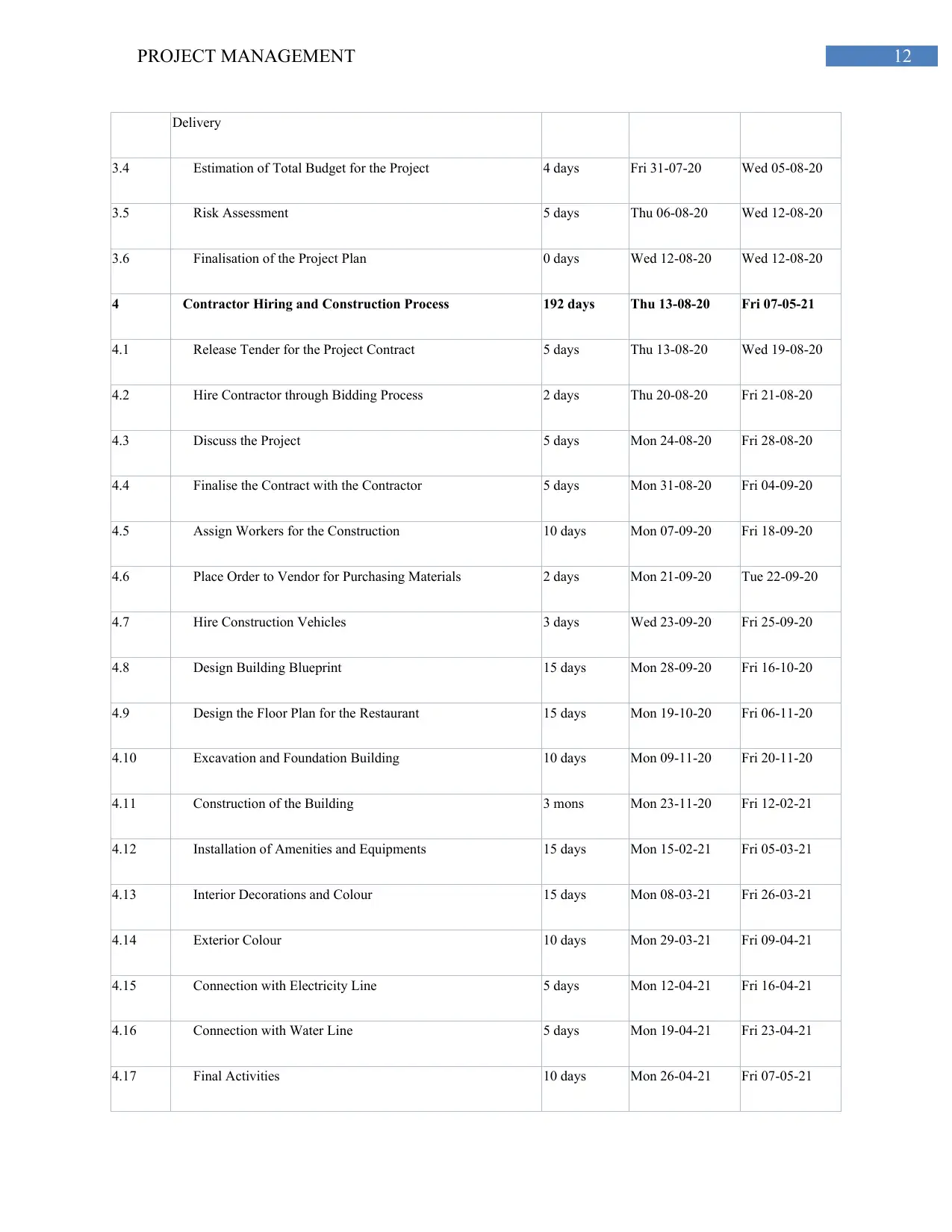
12PROJECT MANAGEMENT
Delivery
3.4 Estimation of Total Budget for the Project 4 days Fri 31-07-20 Wed 05-08-20
3.5 Risk Assessment 5 days Thu 06-08-20 Wed 12-08-20
3.6 Finalisation of the Project Plan 0 days Wed 12-08-20 Wed 12-08-20
4 Contractor Hiring and Construction Process 192 days Thu 13-08-20 Fri 07-05-21
4.1 Release Tender for the Project Contract 5 days Thu 13-08-20 Wed 19-08-20
4.2 Hire Contractor through Bidding Process 2 days Thu 20-08-20 Fri 21-08-20
4.3 Discuss the Project 5 days Mon 24-08-20 Fri 28-08-20
4.4 Finalise the Contract with the Contractor 5 days Mon 31-08-20 Fri 04-09-20
4.5 Assign Workers for the Construction 10 days Mon 07-09-20 Fri 18-09-20
4.6 Place Order to Vendor for Purchasing Materials 2 days Mon 21-09-20 Tue 22-09-20
4.7 Hire Construction Vehicles 3 days Wed 23-09-20 Fri 25-09-20
4.8 Design Building Blueprint 15 days Mon 28-09-20 Fri 16-10-20
4.9 Design the Floor Plan for the Restaurant 15 days Mon 19-10-20 Fri 06-11-20
4.10 Excavation and Foundation Building 10 days Mon 09-11-20 Fri 20-11-20
4.11 Construction of the Building 3 mons Mon 23-11-20 Fri 12-02-21
4.12 Installation of Amenities and Equipments 15 days Mon 15-02-21 Fri 05-03-21
4.13 Interior Decorations and Colour 15 days Mon 08-03-21 Fri 26-03-21
4.14 Exterior Colour 10 days Mon 29-03-21 Fri 09-04-21
4.15 Connection with Electricity Line 5 days Mon 12-04-21 Fri 16-04-21
4.16 Connection with Water Line 5 days Mon 19-04-21 Fri 23-04-21
4.17 Final Activities 10 days Mon 26-04-21 Fri 07-05-21
Delivery
3.4 Estimation of Total Budget for the Project 4 days Fri 31-07-20 Wed 05-08-20
3.5 Risk Assessment 5 days Thu 06-08-20 Wed 12-08-20
3.6 Finalisation of the Project Plan 0 days Wed 12-08-20 Wed 12-08-20
4 Contractor Hiring and Construction Process 192 days Thu 13-08-20 Fri 07-05-21
4.1 Release Tender for the Project Contract 5 days Thu 13-08-20 Wed 19-08-20
4.2 Hire Contractor through Bidding Process 2 days Thu 20-08-20 Fri 21-08-20
4.3 Discuss the Project 5 days Mon 24-08-20 Fri 28-08-20
4.4 Finalise the Contract with the Contractor 5 days Mon 31-08-20 Fri 04-09-20
4.5 Assign Workers for the Construction 10 days Mon 07-09-20 Fri 18-09-20
4.6 Place Order to Vendor for Purchasing Materials 2 days Mon 21-09-20 Tue 22-09-20
4.7 Hire Construction Vehicles 3 days Wed 23-09-20 Fri 25-09-20
4.8 Design Building Blueprint 15 days Mon 28-09-20 Fri 16-10-20
4.9 Design the Floor Plan for the Restaurant 15 days Mon 19-10-20 Fri 06-11-20
4.10 Excavation and Foundation Building 10 days Mon 09-11-20 Fri 20-11-20
4.11 Construction of the Building 3 mons Mon 23-11-20 Fri 12-02-21
4.12 Installation of Amenities and Equipments 15 days Mon 15-02-21 Fri 05-03-21
4.13 Interior Decorations and Colour 15 days Mon 08-03-21 Fri 26-03-21
4.14 Exterior Colour 10 days Mon 29-03-21 Fri 09-04-21
4.15 Connection with Electricity Line 5 days Mon 12-04-21 Fri 16-04-21
4.16 Connection with Water Line 5 days Mon 19-04-21 Fri 23-04-21
4.17 Final Activities 10 days Mon 26-04-21 Fri 07-05-21
Paraphrase This Document
Need a fresh take? Get an instant paraphrase of this document with our AI Paraphraser
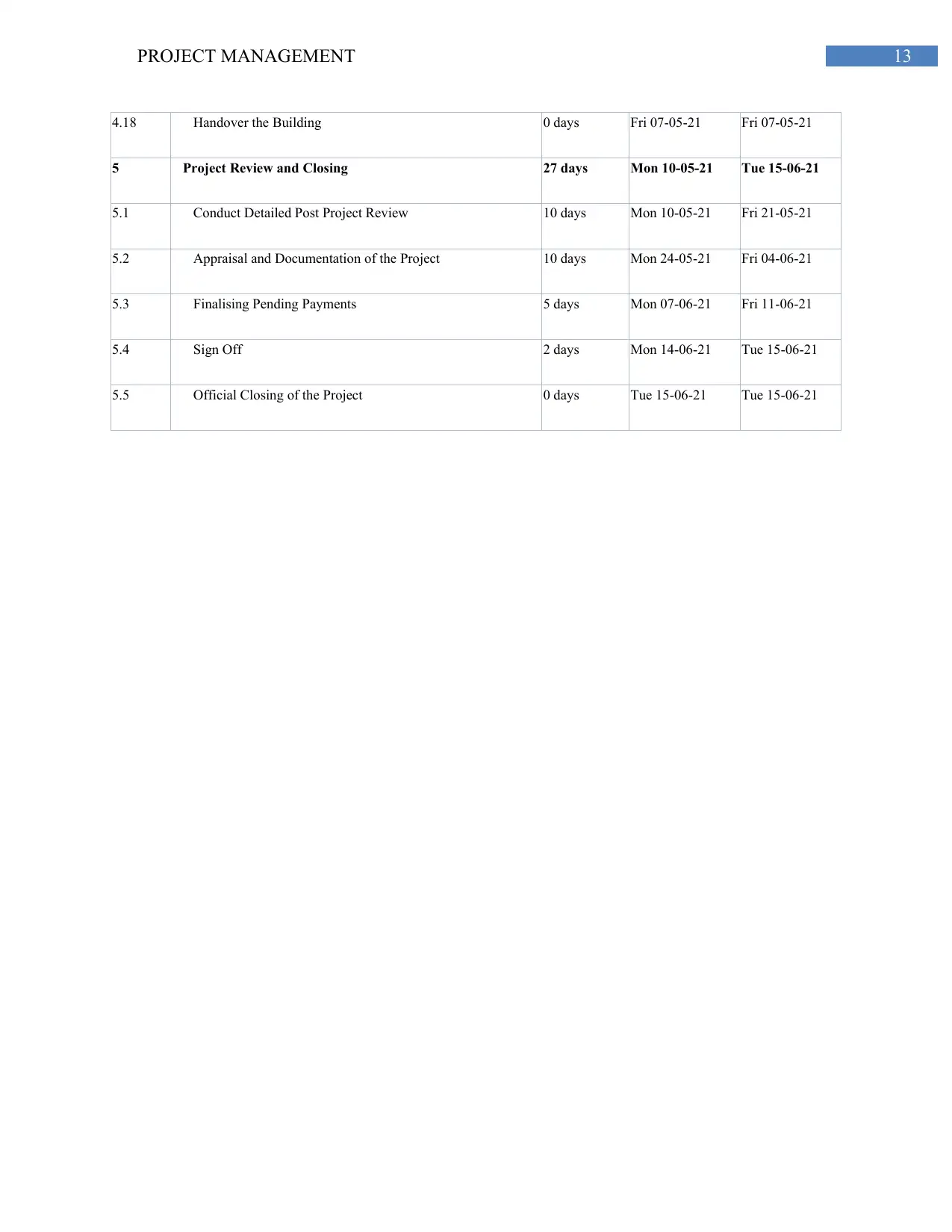
13PROJECT MANAGEMENT
4.18 Handover the Building 0 days Fri 07-05-21 Fri 07-05-21
5 Project Review and Closing 27 days Mon 10-05-21 Tue 15-06-21
5.1 Conduct Detailed Post Project Review 10 days Mon 10-05-21 Fri 21-05-21
5.2 Appraisal and Documentation of the Project 10 days Mon 24-05-21 Fri 04-06-21
5.3 Finalising Pending Payments 5 days Mon 07-06-21 Fri 11-06-21
5.4 Sign Off 2 days Mon 14-06-21 Tue 15-06-21
5.5 Official Closing of the Project 0 days Tue 15-06-21 Tue 15-06-21
4.18 Handover the Building 0 days Fri 07-05-21 Fri 07-05-21
5 Project Review and Closing 27 days Mon 10-05-21 Tue 15-06-21
5.1 Conduct Detailed Post Project Review 10 days Mon 10-05-21 Fri 21-05-21
5.2 Appraisal and Documentation of the Project 10 days Mon 24-05-21 Fri 04-06-21
5.3 Finalising Pending Payments 5 days Mon 07-06-21 Fri 11-06-21
5.4 Sign Off 2 days Mon 14-06-21 Tue 15-06-21
5.5 Official Closing of the Project 0 days Tue 15-06-21 Tue 15-06-21
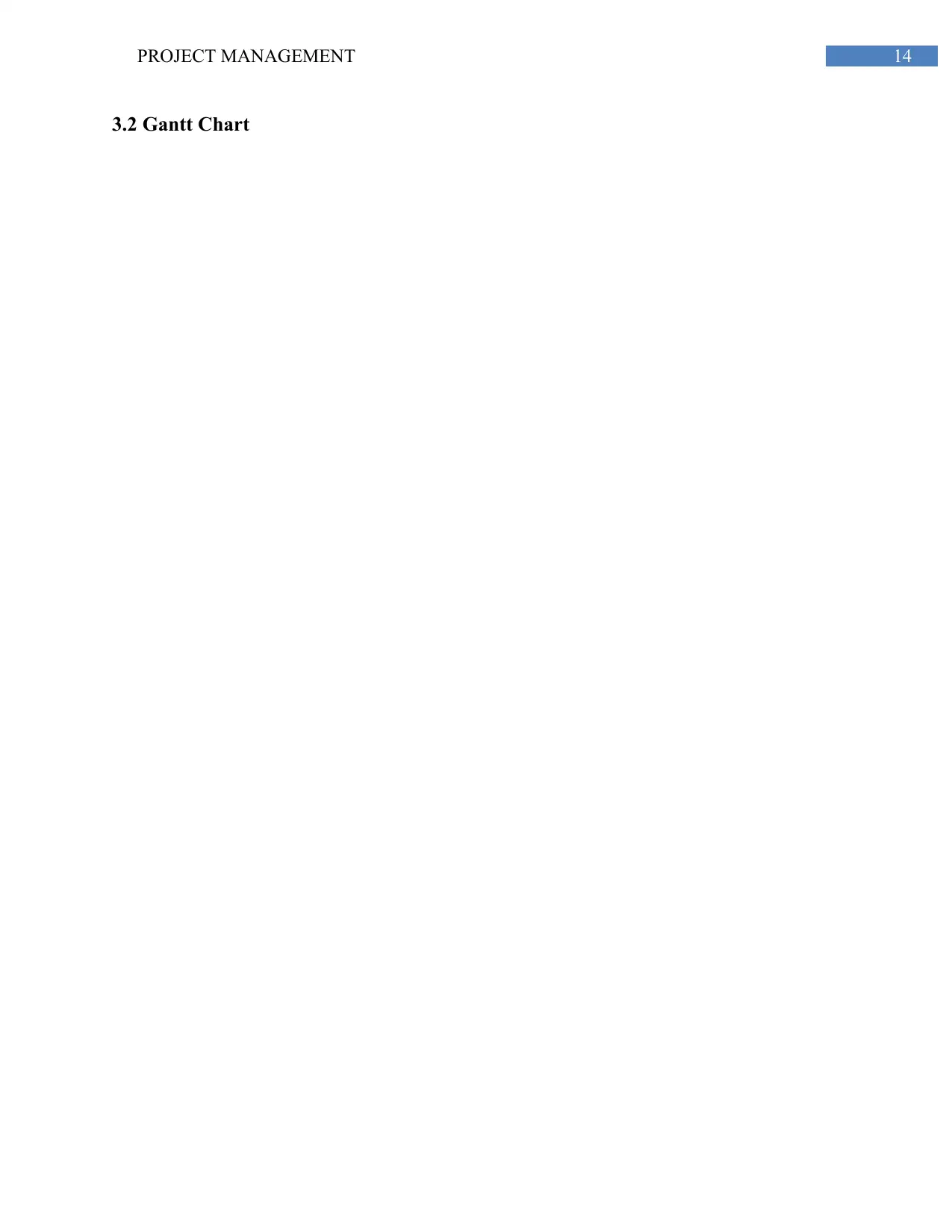
14PROJECT MANAGEMENT
3.2 Gantt Chart
3.2 Gantt Chart
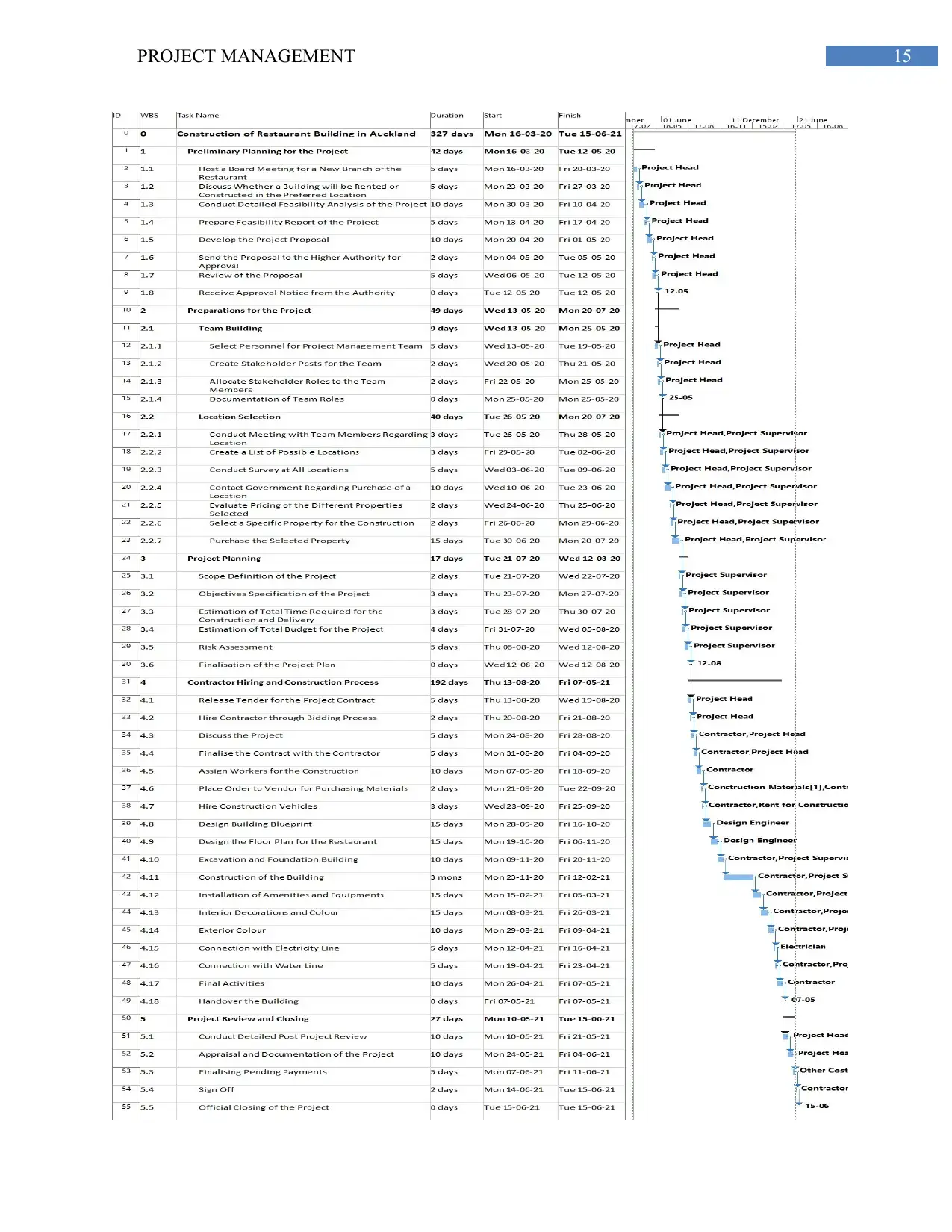
15PROJECT MANAGEMENT
Secure Best Marks with AI Grader
Need help grading? Try our AI Grader for instant feedback on your assignments.
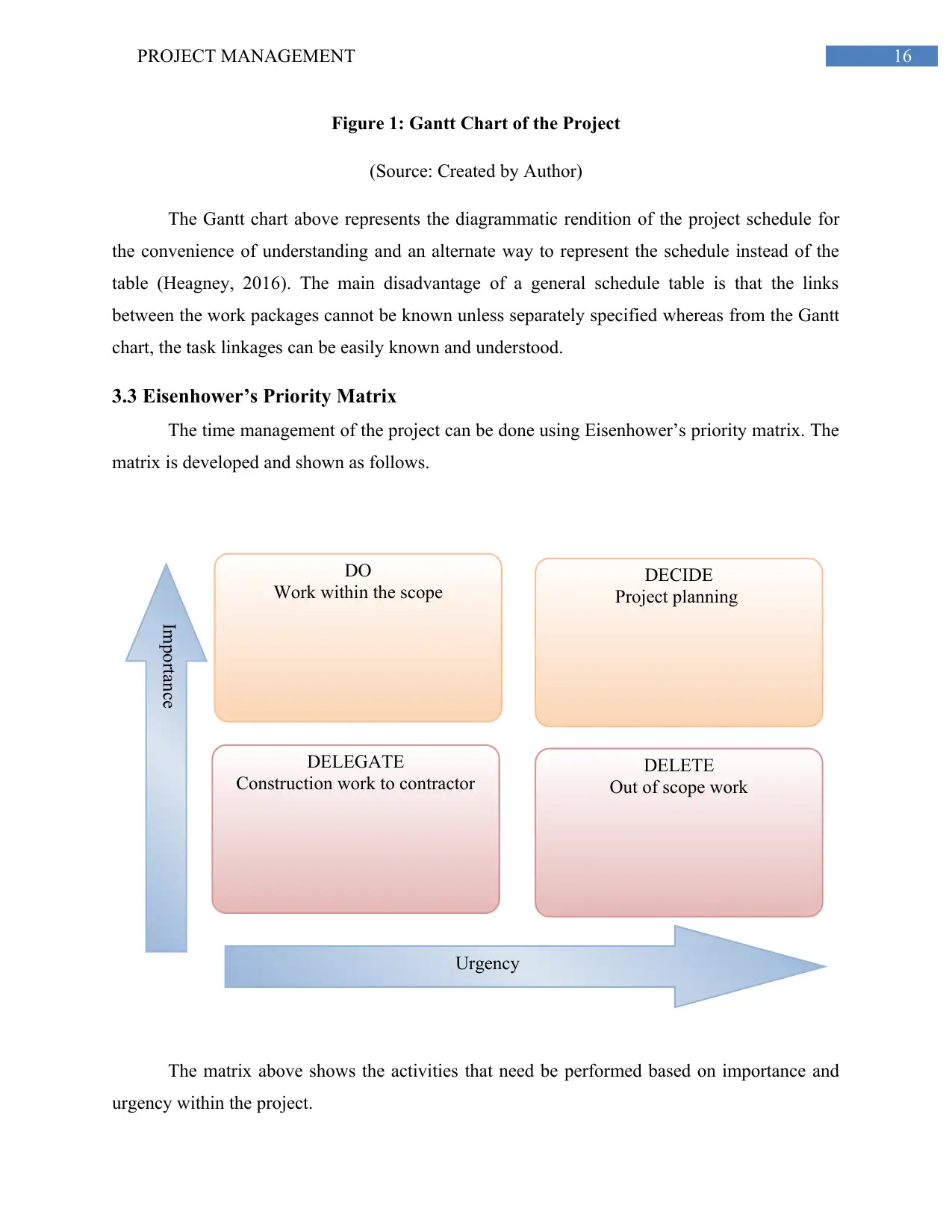
16PROJECT MANAGEMENT
DO
Work within the scope DECIDE
Project planning
DELEGATE
Construction work to contractor DELETE
Out of scope work
Urgency
Importance
Figure 1: Gantt Chart of the Project
(Source: Created by Author)
The Gantt chart above represents the diagrammatic rendition of the project schedule for
the convenience of understanding and an alternate way to represent the schedule instead of the
table (Heagney, 2016). The main disadvantage of a general schedule table is that the links
between the work packages cannot be known unless separately specified whereas from the Gantt
chart, the task linkages can be easily known and understood.
3.3 Eisenhower’s Priority Matrix
The time management of the project can be done using Eisenhower’s priority matrix. The
matrix is developed and shown as follows.
The matrix above shows the activities that need be performed based on importance and
urgency within the project.
DO
Work within the scope DECIDE
Project planning
DELEGATE
Construction work to contractor DELETE
Out of scope work
Urgency
Importance
Figure 1: Gantt Chart of the Project
(Source: Created by Author)
The Gantt chart above represents the diagrammatic rendition of the project schedule for
the convenience of understanding and an alternate way to represent the schedule instead of the
table (Heagney, 2016). The main disadvantage of a general schedule table is that the links
between the work packages cannot be known unless separately specified whereas from the Gantt
chart, the task linkages can be easily known and understood.
3.3 Eisenhower’s Priority Matrix
The time management of the project can be done using Eisenhower’s priority matrix. The
matrix is developed and shown as follows.
The matrix above shows the activities that need be performed based on importance and
urgency within the project.
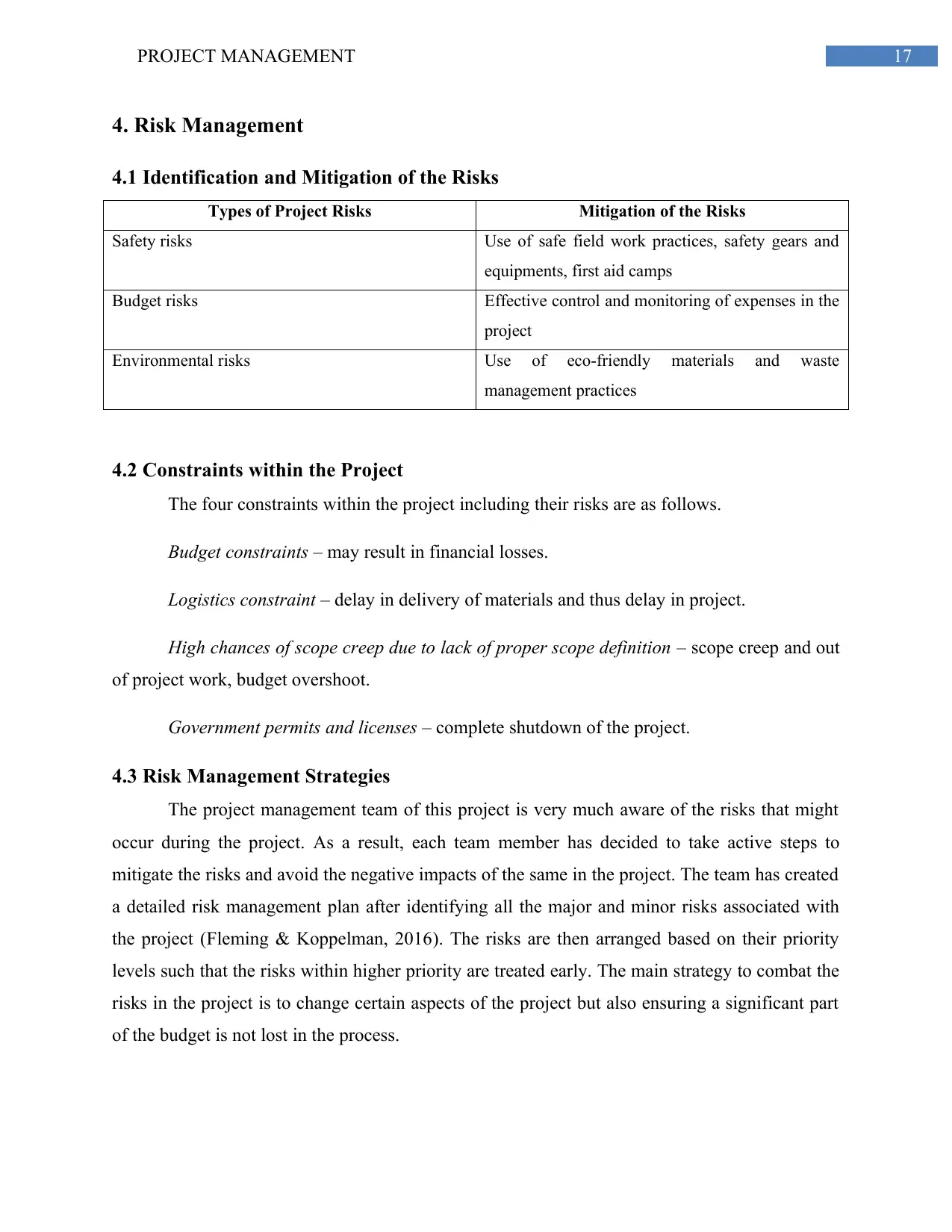
17PROJECT MANAGEMENT
4. Risk Management
4.1 Identification and Mitigation of the Risks
Types of Project Risks Mitigation of the Risks
Safety risks Use of safe field work practices, safety gears and
equipments, first aid camps
Budget risks Effective control and monitoring of expenses in the
project
Environmental risks Use of eco-friendly materials and waste
management practices
4.2 Constraints within the Project
The four constraints within the project including their risks are as follows.
Budget constraints – may result in financial losses.
Logistics constraint – delay in delivery of materials and thus delay in project.
High chances of scope creep due to lack of proper scope definition – scope creep and out
of project work, budget overshoot.
Government permits and licenses – complete shutdown of the project.
4.3 Risk Management Strategies
The project management team of this project is very much aware of the risks that might
occur during the project. As a result, each team member has decided to take active steps to
mitigate the risks and avoid the negative impacts of the same in the project. The team has created
a detailed risk management plan after identifying all the major and minor risks associated with
the project (Fleming & Koppelman, 2016). The risks are then arranged based on their priority
levels such that the risks within higher priority are treated early. The main strategy to combat the
risks in the project is to change certain aspects of the project but also ensuring a significant part
of the budget is not lost in the process.
4. Risk Management
4.1 Identification and Mitigation of the Risks
Types of Project Risks Mitigation of the Risks
Safety risks Use of safe field work practices, safety gears and
equipments, first aid camps
Budget risks Effective control and monitoring of expenses in the
project
Environmental risks Use of eco-friendly materials and waste
management practices
4.2 Constraints within the Project
The four constraints within the project including their risks are as follows.
Budget constraints – may result in financial losses.
Logistics constraint – delay in delivery of materials and thus delay in project.
High chances of scope creep due to lack of proper scope definition – scope creep and out
of project work, budget overshoot.
Government permits and licenses – complete shutdown of the project.
4.3 Risk Management Strategies
The project management team of this project is very much aware of the risks that might
occur during the project. As a result, each team member has decided to take active steps to
mitigate the risks and avoid the negative impacts of the same in the project. The team has created
a detailed risk management plan after identifying all the major and minor risks associated with
the project (Fleming & Koppelman, 2016). The risks are then arranged based on their priority
levels such that the risks within higher priority are treated early. The main strategy to combat the
risks in the project is to change certain aspects of the project but also ensuring a significant part
of the budget is not lost in the process.
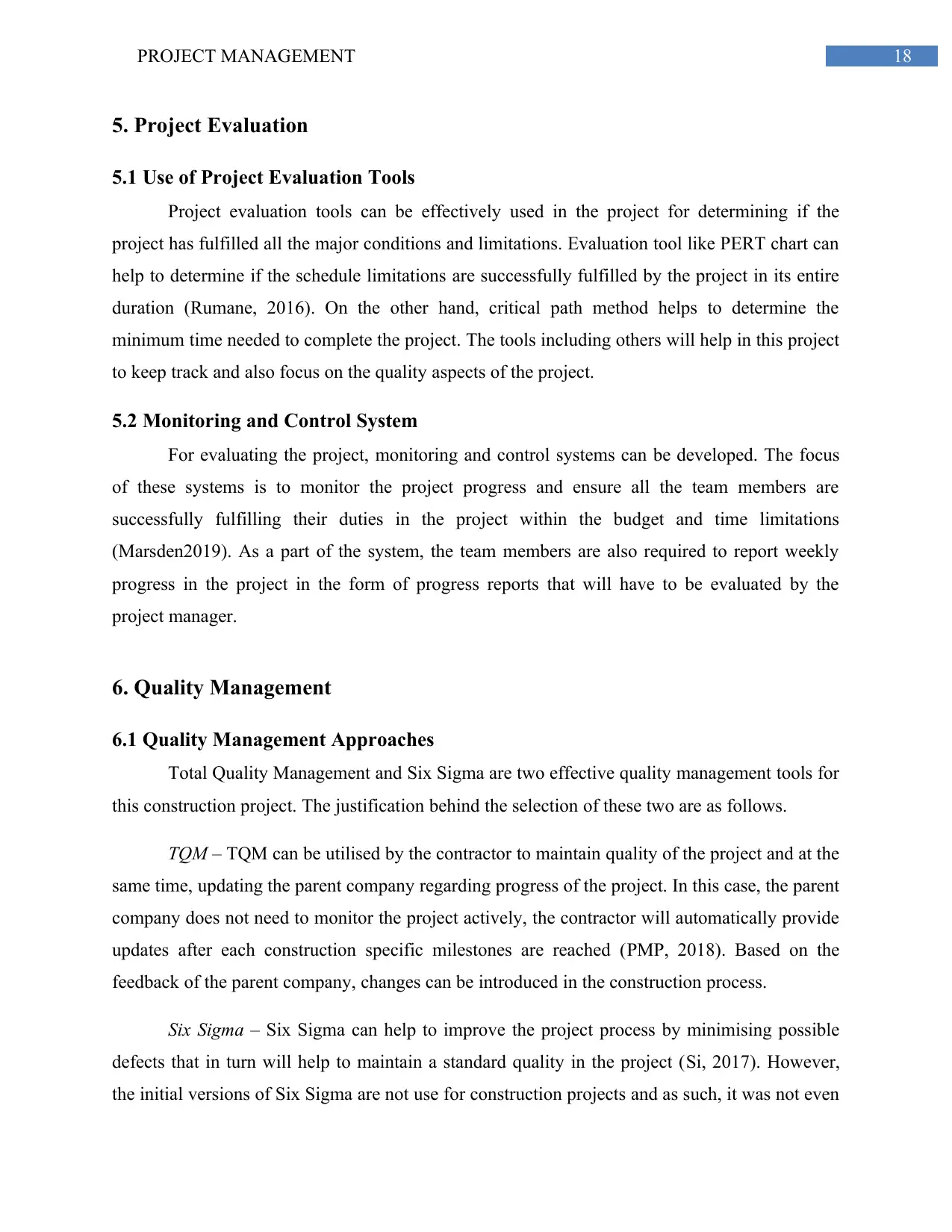
18PROJECT MANAGEMENT
5. Project Evaluation
5.1 Use of Project Evaluation Tools
Project evaluation tools can be effectively used in the project for determining if the
project has fulfilled all the major conditions and limitations. Evaluation tool like PERT chart can
help to determine if the schedule limitations are successfully fulfilled by the project in its entire
duration (Rumane, 2016). On the other hand, critical path method helps to determine the
minimum time needed to complete the project. The tools including others will help in this project
to keep track and also focus on the quality aspects of the project.
5.2 Monitoring and Control System
For evaluating the project, monitoring and control systems can be developed. The focus
of these systems is to monitor the project progress and ensure all the team members are
successfully fulfilling their duties in the project within the budget and time limitations
(Marsden2019). As a part of the system, the team members are also required to report weekly
progress in the project in the form of progress reports that will have to be evaluated by the
project manager.
6. Quality Management
6.1 Quality Management Approaches
Total Quality Management and Six Sigma are two effective quality management tools for
this construction project. The justification behind the selection of these two are as follows.
TQM – TQM can be utilised by the contractor to maintain quality of the project and at the
same time, updating the parent company regarding progress of the project. In this case, the parent
company does not need to monitor the project actively, the contractor will automatically provide
updates after each construction specific milestones are reached (PMP, 2018). Based on the
feedback of the parent company, changes can be introduced in the construction process.
Six Sigma – Six Sigma can help to improve the project process by minimising possible
defects that in turn will help to maintain a standard quality in the project (Si, 2017). However,
the initial versions of Six Sigma are not use for construction projects and as such, it was not even
5. Project Evaluation
5.1 Use of Project Evaluation Tools
Project evaluation tools can be effectively used in the project for determining if the
project has fulfilled all the major conditions and limitations. Evaluation tool like PERT chart can
help to determine if the schedule limitations are successfully fulfilled by the project in its entire
duration (Rumane, 2016). On the other hand, critical path method helps to determine the
minimum time needed to complete the project. The tools including others will help in this project
to keep track and also focus on the quality aspects of the project.
5.2 Monitoring and Control System
For evaluating the project, monitoring and control systems can be developed. The focus
of these systems is to monitor the project progress and ensure all the team members are
successfully fulfilling their duties in the project within the budget and time limitations
(Marsden2019). As a part of the system, the team members are also required to report weekly
progress in the project in the form of progress reports that will have to be evaluated by the
project manager.
6. Quality Management
6.1 Quality Management Approaches
Total Quality Management and Six Sigma are two effective quality management tools for
this construction project. The justification behind the selection of these two are as follows.
TQM – TQM can be utilised by the contractor to maintain quality of the project and at the
same time, updating the parent company regarding progress of the project. In this case, the parent
company does not need to monitor the project actively, the contractor will automatically provide
updates after each construction specific milestones are reached (PMP, 2018). Based on the
feedback of the parent company, changes can be introduced in the construction process.
Six Sigma – Six Sigma can help to improve the project process by minimising possible
defects that in turn will help to maintain a standard quality in the project (Si, 2017). However,
the initial versions of Six Sigma are not use for construction projects and as such, it was not even
Paraphrase This Document
Need a fresh take? Get an instant paraphrase of this document with our AI Paraphraser
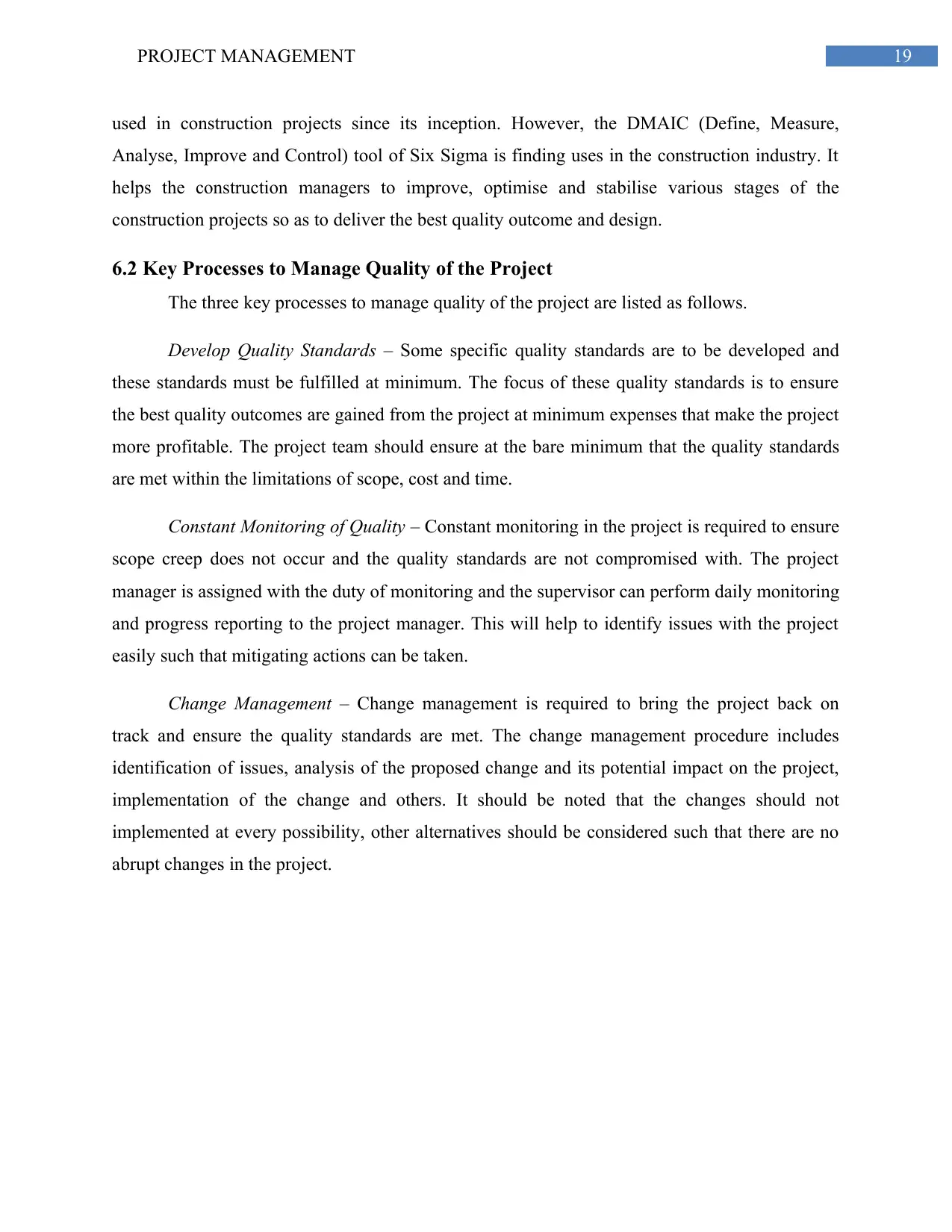
19PROJECT MANAGEMENT
used in construction projects since its inception. However, the DMAIC (Define, Measure,
Analyse, Improve and Control) tool of Six Sigma is finding uses in the construction industry. It
helps the construction managers to improve, optimise and stabilise various stages of the
construction projects so as to deliver the best quality outcome and design.
6.2 Key Processes to Manage Quality of the Project
The three key processes to manage quality of the project are listed as follows.
Develop Quality Standards – Some specific quality standards are to be developed and
these standards must be fulfilled at minimum. The focus of these quality standards is to ensure
the best quality outcomes are gained from the project at minimum expenses that make the project
more profitable. The project team should ensure at the bare minimum that the quality standards
are met within the limitations of scope, cost and time.
Constant Monitoring of Quality – Constant monitoring in the project is required to ensure
scope creep does not occur and the quality standards are not compromised with. The project
manager is assigned with the duty of monitoring and the supervisor can perform daily monitoring
and progress reporting to the project manager. This will help to identify issues with the project
easily such that mitigating actions can be taken.
Change Management – Change management is required to bring the project back on
track and ensure the quality standards are met. The change management procedure includes
identification of issues, analysis of the proposed change and its potential impact on the project,
implementation of the change and others. It should be noted that the changes should not
implemented at every possibility, other alternatives should be considered such that there are no
abrupt changes in the project.
used in construction projects since its inception. However, the DMAIC (Define, Measure,
Analyse, Improve and Control) tool of Six Sigma is finding uses in the construction industry. It
helps the construction managers to improve, optimise and stabilise various stages of the
construction projects so as to deliver the best quality outcome and design.
6.2 Key Processes to Manage Quality of the Project
The three key processes to manage quality of the project are listed as follows.
Develop Quality Standards – Some specific quality standards are to be developed and
these standards must be fulfilled at minimum. The focus of these quality standards is to ensure
the best quality outcomes are gained from the project at minimum expenses that make the project
more profitable. The project team should ensure at the bare minimum that the quality standards
are met within the limitations of scope, cost and time.
Constant Monitoring of Quality – Constant monitoring in the project is required to ensure
scope creep does not occur and the quality standards are not compromised with. The project
manager is assigned with the duty of monitoring and the supervisor can perform daily monitoring
and progress reporting to the project manager. This will help to identify issues with the project
easily such that mitigating actions can be taken.
Change Management – Change management is required to bring the project back on
track and ensure the quality standards are met. The change management procedure includes
identification of issues, analysis of the proposed change and its potential impact on the project,
implementation of the change and others. It should be noted that the changes should not
implemented at every possibility, other alternatives should be considered such that there are no
abrupt changes in the project.
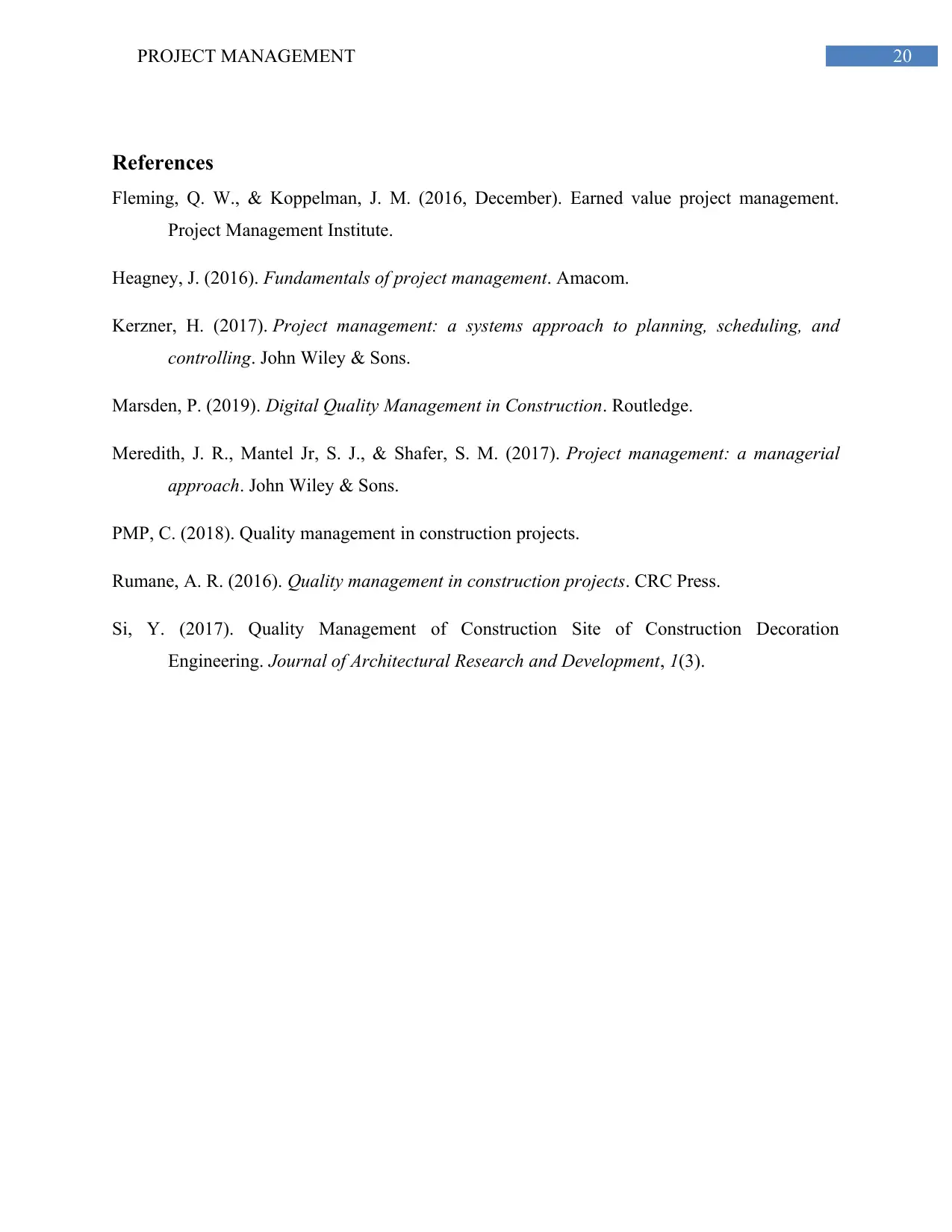
20PROJECT MANAGEMENT
References
Fleming, Q. W., & Koppelman, J. M. (2016, December). Earned value project management.
Project Management Institute.
Heagney, J. (2016). Fundamentals of project management. Amacom.
Kerzner, H. (2017). Project management: a systems approach to planning, scheduling, and
controlling. John Wiley & Sons.
Marsden, P. (2019). Digital Quality Management in Construction. Routledge.
Meredith, J. R., Mantel Jr, S. J., & Shafer, S. M. (2017). Project management: a managerial
approach. John Wiley & Sons.
PMP, C. (2018). Quality management in construction projects.
Rumane, A. R. (2016). Quality management in construction projects. CRC Press.
Si, Y. (2017). Quality Management of Construction Site of Construction Decoration
Engineering. Journal of Architectural Research and Development, 1(3).
References
Fleming, Q. W., & Koppelman, J. M. (2016, December). Earned value project management.
Project Management Institute.
Heagney, J. (2016). Fundamentals of project management. Amacom.
Kerzner, H. (2017). Project management: a systems approach to planning, scheduling, and
controlling. John Wiley & Sons.
Marsden, P. (2019). Digital Quality Management in Construction. Routledge.
Meredith, J. R., Mantel Jr, S. J., & Shafer, S. M. (2017). Project management: a managerial
approach. John Wiley & Sons.
PMP, C. (2018). Quality management in construction projects.
Rumane, A. R. (2016). Quality management in construction projects. CRC Press.
Si, Y. (2017). Quality Management of Construction Site of Construction Decoration
Engineering. Journal of Architectural Research and Development, 1(3).
1 out of 21
Related Documents
Your All-in-One AI-Powered Toolkit for Academic Success.
+13062052269
info@desklib.com
Available 24*7 on WhatsApp / Email
![[object Object]](/_next/static/media/star-bottom.7253800d.svg)
Unlock your academic potential
© 2024 | Zucol Services PVT LTD | All rights reserved.





